








The tap that delivers 100 °C boiling, hot, cold, and sparkling water instantly, all from one tap
Whether you’re entertaining guests, preparing gourmet meals, or enjoying a refreshing drink, Quooker brings effortless luxury to your kitchen. Experience Quooker at our Dubai Showroom or visit www.quooker.ae to book your exclusive consultation
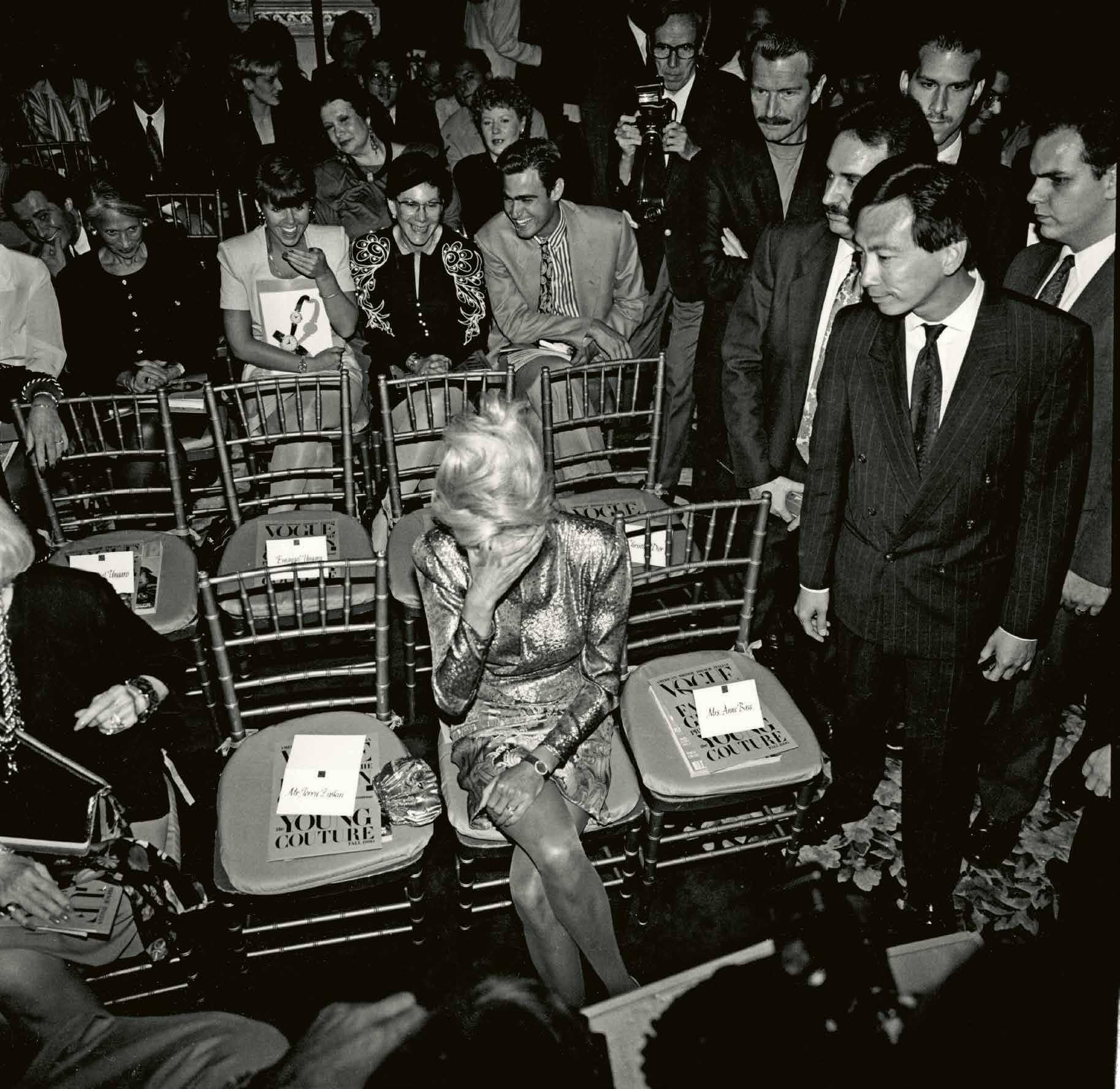
Thirty Four From Teen To Queen Kirsten Dunst on movie industry predators, Tom Cruise’s kindness and why Sofia Coppola is her staunchest ally in the industry.
Forty A Cut Above
Men of distinction have long turned to Dunhill for tailoring, and with a new creative director at its helm, more will be following suit.
Forty Six Access All Areas
In 1990s New York, photographer Dafydd Jones infiltrated the world of the elite and the influential, capturing their antics up close.



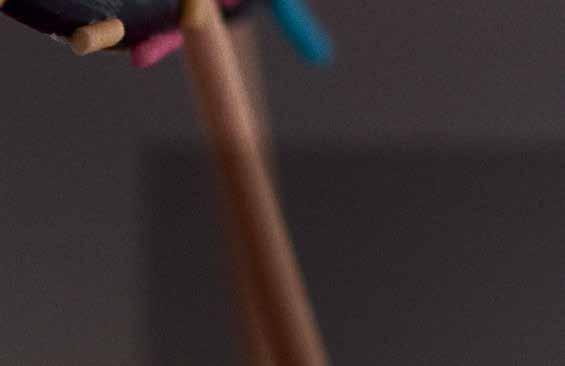





Fourteen Radar
Sixteen Objects of Desire
Eighteen Art & Design
Twenty Four Jewellery
Fifty Four Motoring
Fifty Eight Gastronomy
Sixty Two Travel
Sixty Four What I Know Now

Thirty Timepieces
Chanel’s couture atelier and the many tools it houses are the inspiration for a capsule collection big on creative boldness.
Editor-in-Chief & Co-owner
John Thatcher
john@hotmedia.me
COMMERCIAL
Managing Director & Co-owner
Victoria Thatcher
PRODUCTION
Digital Media Manager Muthu Kumar
Within a secluded archipelago in the bountiful Red Sea, a story thousands of years old is waiting to be told. Born from the stars of the infinite sky above and the colorful reef below, Nujuma, a Ritz-Carlton Reserve carries on the traditions of those who traveled across uncharted territory to discover pristine natural beauty, rich cultural heritage and flavors as vivid as the sea itself. Surrounded by crystal-clear water and soft white sand, Nujuma is an unspoiled sanctuary where exploration unveils a constellation of unforgettable experiences.
Accessed by chartered boat or seaplane, Nujuma features 63 overwater and beach villas, offering one-to-three-bedroom accommodation, spacious living areas and private pools overlooking the sea, while each enjoys the services of a dedicated personal host, who will take care of every detail and guide guests through all the enriching experiences this destination has to offer, including five unique culinary concepts and a tranquil spa.

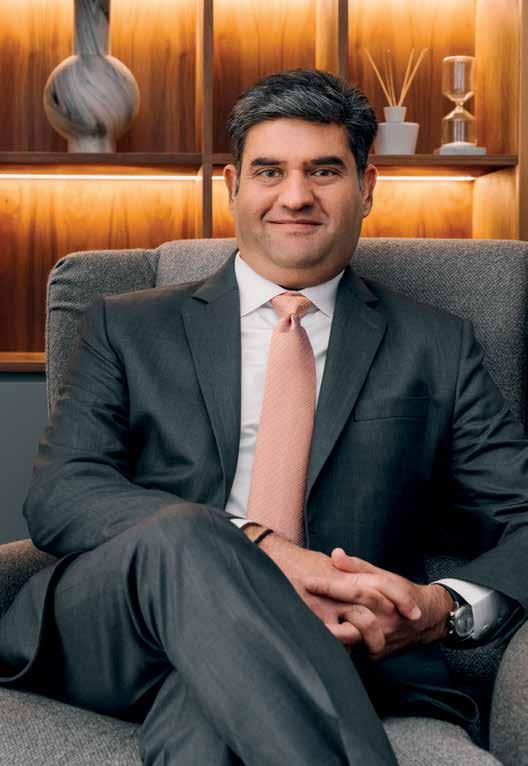
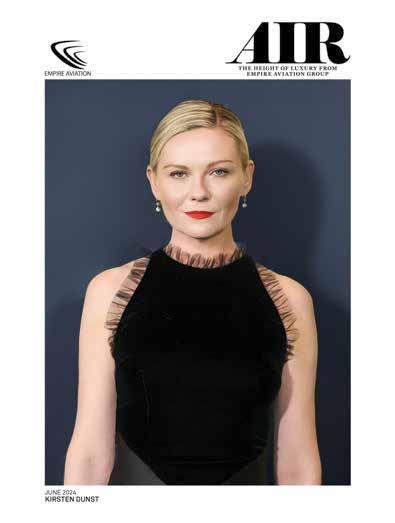
Welcome to this issue of AIR, our luxury lifestyle magazine. If you’re travelling on one of our Empire-operated business jets, we wish you a relaxing flight and hope you enjoy the service in the very capable hands of our crew.
Aircraft management is our core service in which we manage every aspect of an aircraft, its maintenance and operation, on behalf of the owner. The skills required to be a successful aircraft management team range from the deeply technical – after all, we are dealing with a highly complex and advanced piece of aviation technology – to the financial management of a very high value asset and investment.
But a business jet is also a very special and personal space that delivers unique benefits and travel experiences. These include highly personalised customer service, exceptional comfort, privacy and confidentiality, as well as safety and security. It takes an expert team of committed professionals to deliver these experiences.
At Empire Aviation, we have our own inhouse quality control executives, technical support and maintenance team, as well as flight dispatch, flight operations, and ground operations staff. At the helm of this elite group are exceptionally skilled and seasoned director-level executives, whose expertise in business aviation is unparalleled. Their wealth of experience and leadership acumen not only guides but elevates the overall performance of our team, setting a standard of excellence that is ingrained in every aspect of our operations, including our aircraft management services.
In this issue, we discuss some of the skillsets needed to be successful in aircraft management. Since 2007, Empire has managed business jets from all the major manufacturers, including Bombardier, Dassault and Gulfstream.
Among the aircraft under the care of the Empire Aviation team, a notable favourite is the Legacy 600 alongside its counterpart, the Legacy 650, manufactured by Embraer Executive Jets since 2002. Renowned as a ‘workhorse’ in executive aviation due to its competitive operating costs, generous luggage storage capacity and comfortable and spacious seating areas, this aircraft has consistently proven to be a popular choice for both aircraft owners and charter customers.
You can read more about the Legacy 600/650 in this issue and you can check the website for the Legacys we have on our charter fleet – your aircraft is just a click away.
Enjoy the read.
Paras P. Dhamecha Managing Director Empire Aviation GroupSince launching in Dubai UAE in 2007, Empire Aviation Group has developed into a global private aviation business integrating a comprehensive range of services, based on a distinctive aircraft management approach and personalised service, ensuring aircraft owners and clients enjoy all the privacy, safety, comfort and convenience of private aviation. Empire Aviation operates one of the Middle East’s largest managed fleets of business jets, with aircraft based in global locations. The company operates in the key regions for private aviation, covering the USA, Europe, India, Africa and Indonesia, in addition to the Middle East. The Empire Aviation team comprises 130 aviation specialists across the globe. Empire Aviation holds AOCs (Air Operator Certificates) in the UAE and San Marino.
Contact Details: info@empire.aero empireaviation.com
The importance of building a strong and enduring relationship between aircraft owner and management company

Aircraft management is both a science and an art, incorporating the hard and soft skills required to understand and manage the advanced technology embedded in a modern business jet –from nose to tail, from the flight deck avionics to the increasingly technologyenabled cabins - along with the ability to deliver exceptional customer services and build relationships with owners, based on transparency and trust. It’s clear that due diligence is required to ensure the right match between aircraft owner and aircraft manager, and this can come down to the right level and balance of skills. Of course, safety will be the number one priority and this can be seen through safety records and safety certifications. When it comes to the quality of management and customer services provided, arguably the best test is to speak to existing owners (within the restrictions of any privacy agreements of course). Aviation is all about people and the art of management is in building
relationships that ensure owners enjoy the best possible experiences from a committed, professional team. The key words are ‘quality’, ‘transparency’ and ‘trust’. These can be difficult to measure but trust is the most important and most powerful. There are a number of professional and personal skills that a successful management team must develop and demonstrate to achieve a high level of owner trust.
In a very dynamic, technical and complex industry such as aviation, technical expertise is essential across aircraft systems, maintenance, and safety protocols. This extends to digital technology, which is transforming aviation, from flightdeck avionics to cabin communications but also back-office functions, including flight planning and maintenance management software.
The financial management of multimillion-dollar aircraft assets is a fundamental skill area, especially for an asset management approach to aircraft
ownership. This means not only efficient and timely budgeting, revenue and cost control but transparency for owners. A focus on customer service, owner satisfaction and passenger experience is essential and at the core of the relationship between aircraft manager and owner. Aircraft owners are rightfully demanding and expect 5-star service (proactive problem solving and close attention to detail) on the ground and in the air, at every touchpoint. The ability to communicate effectively, work to deadlines and empathise with a diverse range of owners, is critical and part of the overall professionalism that all staff, in whatever role, must demonstrate constantly. These are the key skills and the basis for building strong and enduring relationships. It's the combination of IQ and EQ that makes the difference. But it’s also a team game and requires effective leadership that will ultimately build the confidence and trust of aircraft owners.

Empire Aviation’s charter fleet features the Embraer Legacy 600 and 650

With two Legacy business jets on the charter fleet, the question is which to choose – the Legacy 600 or Legacy 650? The Embraer 600/650 aircraft are highly popular and exceptional large business jets that offer an attractive package of size, range and operating cost for charter customers. The aircraft has an impressive dispatch reliability and also scores highly on luggage capacity – an all-important feature for those family vacations. Brazil-based Embraer – or Empresa Brasileira de Aeronáutica SA aerospace company, to use the full title - began manufacturing the Legacy 600 large business jet in 2002. The twin-engine aircraft actually performed its first flight in 2001 and entered service a year later. It became very popular thanks to its unique three-partitioned cabin section, offering flexibility for operators and passengers. Operated by a crew of two (captain and co-pilot)
and one flight attendant, the aircraft can accommodate up to 13 passengers. The Embraer Legacy 600’s spacious cabin offers exceptional flexibility. Whether a two-hour daytime hop or a medium-haul overnight flight, passengers are assured optimal comfort. Comfortable reclining seating can be configured based on preferences. When it is time to rest, the seating can be transformed into six sleepers (with a lie-flat bed configuration). At 1.83m tall, the cabin offers plenty of headroom and is fully equipped with an entertainment system to meet every passenger’s preference. Depending on the number of passengers, the Legacy 600 can fly up to 3,250 nautical miles. With a maximum speed of 514mph and luggage capacity of 286 cubic feet, it will take you and all your gear to your destination quickly and comfortably. The Legacy 650 is an update of the

600 and incorporates some attractive additional features. With an extended range and equipped with broadband Wi-Fi to keep passengers connected, it’s a popular charter option for a maximum of 13 passengers flying up to 3,400 nautical miles. It also has one of the largest-in-class, in-flightaccessible baggage compartments. Both Embraers are truly exceptional aircraft for business or leisure charter clients and so the only decision is – the 600 or 650? It’s really just a question of how far you want to go.



Returning this month for the second time after making waves with its debut last year, the Richard Mille Cup will see a fleet of 12 vintage sailing yachts set sail from Falmouth in England to Le Havre in France on June 2. Along the way they will partake in a series of thrilling races across nearly two weeks of challenging competition to determine which team will hoist aloft the trophy come June 15. “This is the ideal environment to admire the magnificence and beauty of these classic yachts from the pre-war era,” says Richard Mille.


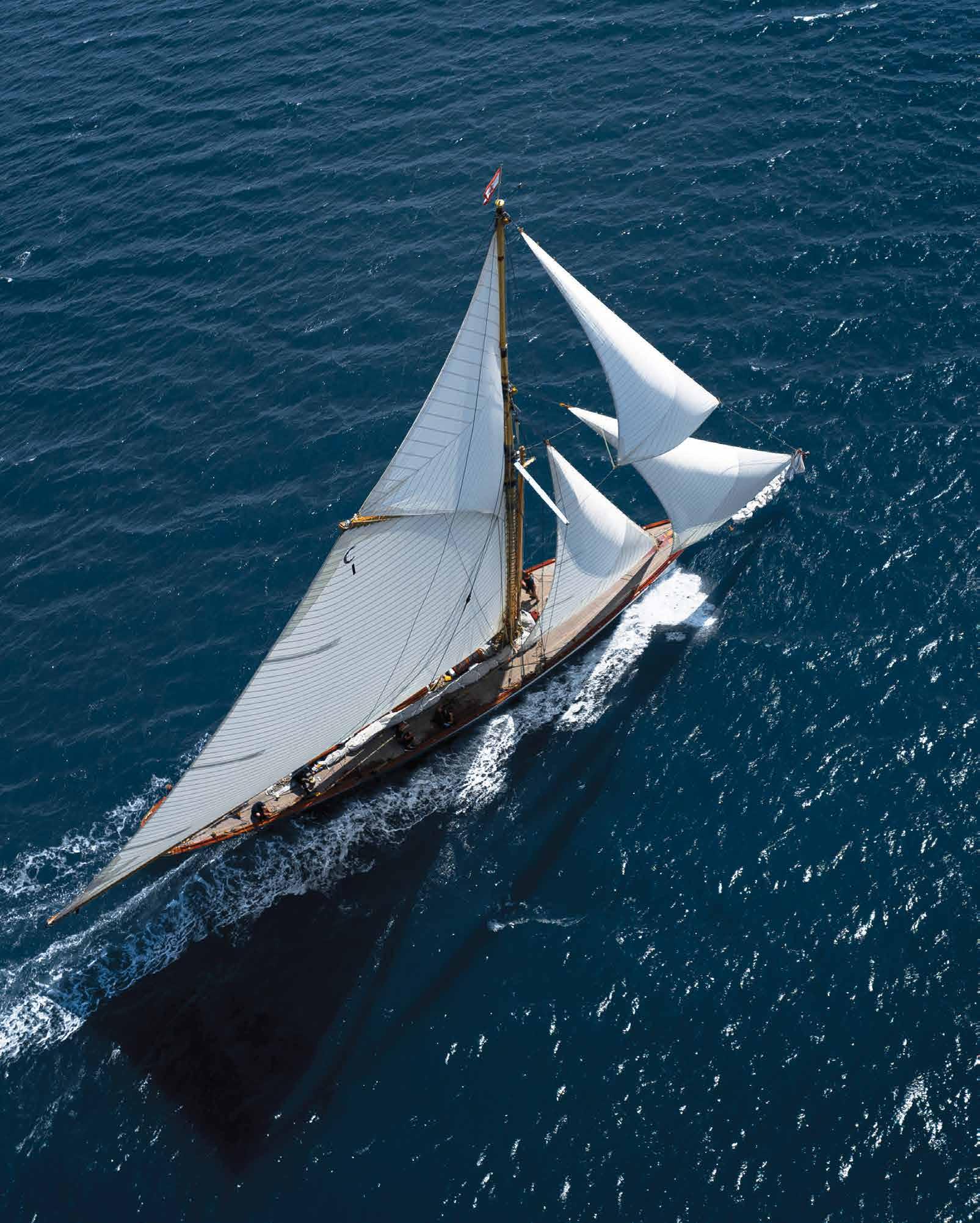
Master craftsmanship, effortless style and timeless appeal; this month’s must-haves and collectibles

The latest collection to stream from the London-based workshop of David Morris features this spectacular Riviera necklace, a comtemporary take on a traditional style for which rows of captivating gemstones (in this case, 29.51cts worth of beautiful white diamonds set in 18ct white gold) were
designed to flow effortlessly across the collarbone when worn. “Riviera is our take on a classic rivière necklace,” says Jeremy Morris, CEO and Creative Director of the decades-old brand. “It’s finely crafted to sit lightly on the skin and be very easy to wear.”

TAG HEUER MONACO SPLIT SECONDS CHRONOGRAPH
In the early 1900s, TAG Heuer set out to master the split-seconds chronograph complication. More than a century on, it’s fair to say that it has since succeeded. The latest addition to a long line of such watches – which includes, from 1989, a quartz split-seconds
OBJECTS OF DESIRE 2
chronograph wristwatch worn by racing legend Ayrton Senna – is the Monaco Split-Seconds Chronograph. Available in blue or red editions, it features the newly launched TH81-00, one of the lightest automatic chronograph movements ever created by TAG Heuer.

Famed for her fabulous silk nightwear, Olivia von Halle has paired up with her longtime friend, the London-based jeweller Jessica McCormack, to create a capsule collection of sleepwear for which the Yves Desire pyjama is the stuff of dreams. Embroidered with Jessica’s
signature inscription ‘my heart my eye‘, the made-to-order ivory pyjama also features opulent buttons in the form of diamonds and rubies, each one handcrafted in Jessica McCormack’s Mayfair-based townhouse. Said McCormack: “There’s something about pjs and diamonds that just works!”
OBJECTS OF DESIRE
OBJECTS OF DESIRE


Blancpain’s iconic Fifty Fathoms – widely hailed as the first true diver’s watch for establishing the fundamental technical and aesthetic codes that remain prevalent today –celebrated its 70th anniversary last year by issuing a 42mm case for the
first time in its long history. Now that size is offered again in the guise of Fifty Fathoms Automatique models. These red gold or grade 23 titanium timepieces come with a wide choice of straps (sail-canvas to textured rubber) coloured blue or black.

PATEK PHILIPPE WORLD TIME REFERENCE
Having been launched last year as a limited-edition piece, Patek Philippe’s World Time Reference 5330G-001 – resplendent in white gold – is now offered as part of the manufacture’s regular collection. Billed as the ‘new-generation’ of World Time, it
features a patented world first: a date display synchronised with local time, a function enabled by a newly developed movement, the self-winding caliber 240 HU C, which includes an innovative differential system to indicate the date on the margin of the dial.

Pomellato’s new flip-sided jewellery line may be inspired by the humble button – a nod to a motif that first appeared as part of the brand’s creative cannon back in 1974, dangling from a gold necklace – but it’s certainly more fabulous than functional. The playful design contains
a gold thread that runs through both sides and comes as a pendant or bracelet in three variants: green malachite on one side and mother of pearl on the other; white diamonds teamed with a mother of pearl reverse; and grey and white mother of pearl.

& CO.
Pharrell Williams, the man with the Midas touch, swaps sides within LVMH to design a collection for Tiffany & Co., one inspired by Poseidon’s trident. Spikes – used since the days of punk to signify fearless individuality – are a common design feature across a range
that spans necklaces, earrings, bracelets and rings, offered in18k yellow gold or titanium. Says Pharrell: “The detail in all of the jewellery pieces is very intentional, the use of black titanium… it’s a physical manifestation of beauty in blackness.”

Few tennis players move around the court as gracefully as threetime Grand Slam winner Stanislas Wawrinka, which is no doubt why Valérie Messika enlisted the Swiss star to front a new campaign that shows how men can effortlessly mix
jewellery pieces without restriction. Case in point, here Wawrinka wears a trio of them: a Move Noa gold bangle; a diamond-paved necklace; and a single diamond-adorned bracelet crafted in black calfskin, both from the My Move collection.
Globally renowned photographer, publisher, and film director Rankin on the magazine images that helped define the Nineties
WORDS: RANKIN
Nobody captured the 90s zeitgeist as creatively as Rankin. During that decade of widespread optimism, the famed photographer shot stars across the cultural landscape, his era-defining images of cult celebrities, supermodels and musicians often appearing on the pages of groundbreaking magazine Dazed & Confused, which Rankin co-founded in 1991. A new exhibition, Back In The Dazed, Rankin 1991-2001, documents that memorable time, pulling together numerous striking editorials Rankin shot for the magazine. “To understand Rankin’s work you need not look any further than the pages of his first magazine, a printed record of his thoughts and reactions to the world around him,” says the exhibition’s curator, Ellen Stone. “Dazed shaped Rankin’s photography and it in turn shaped other’s view of the world. Think of your favourite young actor or pop star from the 1990s –invariably you are remembering a Rankin picture.”
Rankin himself describes the period as one “great for experimentation. For me, just starting out, I was like a blank canvas. Because we were pretty naively fearless, we did things that ended up really changing culture. It was from that time that I learnt that I love what I do, and I fell in love with the people around me – capturing them all on medium format film.”
Here, in an interview for AIR, Rankin reveals the stories behind a selection of those seminal shots… Back In The Dazed, Rankin 1991-2001, 180 Studios, London, until June 23
Jimmy Dixon, Circle Line, Dazed & Confused, Issue 7, 1994
Jimmy Dixon was one of my earlier collaborations for Dazed, and began when I was searching for stylists to work with. I met him through a stylist called John Spencer who had this idea to create a shoot based on the London tube station, the Circle Line. Coloured yellow on a tube map, Jimmy dyed and bleached his hair this colour and we photographed on different destination stops. Funnily enough, this image was taken near to where the Back in the Dazed exhibition is, at 180 Studios.
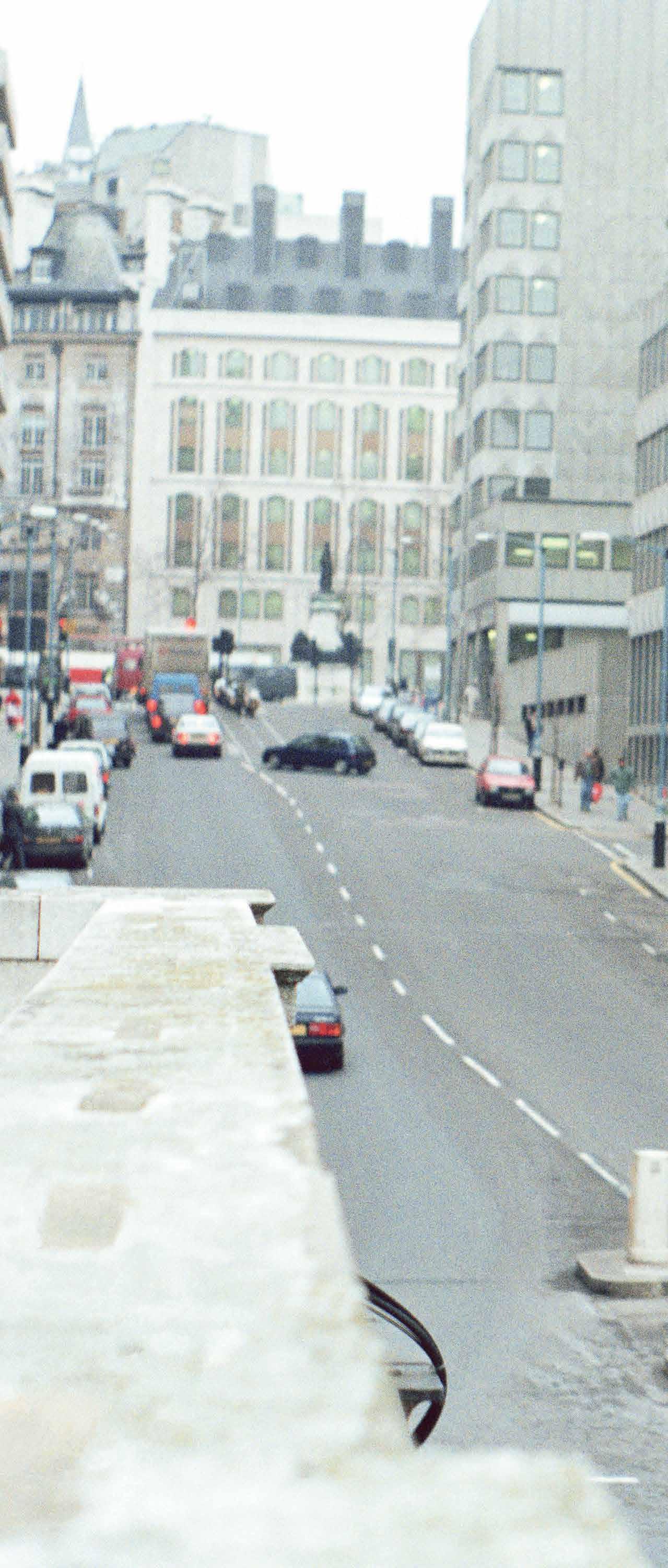


Helen Mirren, On The Wall, Dazed & Confused, Issue 46, 1998
This image of Helen Mirren was commissioned by Alexander McQueen for his 1998 issue of Dazed & Confused Back then, we were all massive fans of Helen’s, especially for her portrayal of a female detective in a procedural drama, by Lynda La Plante. She had always been in our consciousness, and admired for her extraordinary acting skills. Meeting her was a memorable moment; I couldn’t help but think I’ve just met DCI Jane Tennison from one of my favourite TV shows, but then of course she was so much more than that.
Evan Dando from The Lemonheads, Lost & Found, Dazed & Confused, Issue 25, 1999
I was a bit of a Lemonheads fan at the time, and just thought he was so beautiful. He was very playful photographing him. This shot was taken outside the Dazed studios at the time. A lot of our shoots happened because we didn’t have any budgets back then. He had this idea where he wrapped the microphone lead around his head. It was just quite strange because he was so beautiful, and it felt quite counterintuitive for me. Yet, it made a great picture.

David Bowie, No Different from Anyone Else? Dazed & Confused, Issue 14, 1995
Bowie was one of the first celebrities I photographed. It was back in 1995 and I really thought I hit the big time with this shoot. It was a surreal, whirlwind trip to Los Angeles, flying in on Wednesday evening, shooting the next day and back on the plane on the Friday afternoon. This particular shot was among the more conventional ones we captured together, really exemplifying the style of most of my work in the 90s: Bowie leaning into the camera, captured with a wide-angle lens, his gaze meeting the lens directly. He really was just extraordinary to photograph. My initial thought was that he was going to be too cool, almost a bit ‘off’ with me, but he was the exact opposite. He reminded me of Tigger from Winnie-the-Pooh, bouncing around being really playful and funny.


Jude Law, A Law unto Himself, Dazed & Confused, Issue 15, 1995
This shot of Jude was taken in 1995 whilst we were both in New York. I actually spent quite a bit of time with him then, as I knew some people who knew him and we just started hanging out together. Eventually I suggested a shoot together which was just him and me running around the streets of Manhattan. He even
climbed lampposts! This image was when we passed by a McDonald’s with a plastic statue of Ronald McDonald outside. It felt funny to have Jude, who was just starting to get famous and was breaking America, interact with such a symbol of the culture. This picture we got from that moment remains one of my favourites, capturing the spontaneity of our time together.

Kate Moss, What’s The First Word that Comes into Your Head?, Dazed & Confused, Issue 43, 1998:
This was my second shoot with Kate Moss for Dazed. I had wanted to create a conceptual shoot with Kate for ages, something that would stand out creatively. Eventually, the idea of spray painting Kate came up. I can’t remember if it was Jefferson Hack, Katie Grand or Phil Poynter that had the idea. But I loved the thought of styling Kate all in white, almost as a blank canvas.
It’s strange, because I didn’t end up doing many conceptual photoshoots with Kate, which was what I was always trying to do with everything I did in fashion and a lot of portraits. But this stands out as one of my favourite images and shoots from my whole time at the magazine.
Josephine Rukia, Baked Alaska, Diesel Style Lab A/W, Dazed & Confused, Issue 45, 1998
This shoot was for Diesel Style Lab and was a natural extension of my Highly Flammable series, where I photographed cardboard cutouts of models and then photographed them on fire. For this photoshoot at the Dazed studio, we incorporated ice and fire on people’s faces. It was a creative and collaborative process, blending the contrasting forces of fire and ice using special effects. Josephine was such a collaborative model and I did quite a lot with her back then.


Rural Ireland may not be the obvious base for a master goldsmith, but it’s here that Nigel O’Reilly creates extraordinary high jewellery pieces
WORDS: JOHN THATCHER

Every jewellery designer can cite their reason for entering the industry. Having interviewed many of them down the years, their stories tend to emanate from one of two clear inspirations: a family member, or a childhood fascination. Often both. So it’s almost refreshing to hear of Nigel O’Reilly’s offbeat pathway. “It was sparked by a crush I had on a girl – now my wife – and my determination to impress her!” he says, speaking from his studio amid the dramatic, Atlantic-lashed landscape of County Mayo in Ireland. “As a young boy growing up on a farm in rural Ireland, I had no real awareness of jewellery. It wasn’t something that was particularly present in my home. My mother had a wedding band and an engagement ring, and perhaps a few other small pieces, but jewellery, and the arts in general, definitely weren’t a part of my childhood.”
Having found success at school hindered by severe dyslexia, O’Reilly didn’t go to college, as was the norm, instead becoming an apprentice engineer, making moulds for vascular surgery. “That was my profession until I met my wife in a nightclub. She was an art student, so I decided to get creative with my engineering skills and craft some unique rings especially for her. Luckily, she thought they were really cool and asked me if I’d ever thought about going into jewellery. I hadn’t, until that moment.”
The things we do for love. Passion ignited, O’Reilly is now a master goldsmith, someone expert in all the complex processes of jewellery making, everything from hand fabrication through to setting and polishing. As such, he’s a rarity. A fact reflected in his beautiful bespoke pieces, many of which stretch into six figure sums and are coveted by museums as much as the most discerning of customers.
There’s an other-worldly look to The DeVille, an 18ct rose gold fourpointed globe, inside which is a single 14.5mm freshwater pink pearl that completely rotates on its own axis on a cup of blue diamonds. The golden ring that cradles it is latticed and in sections, each one pavé set with white, blue and pink diamonds totalling 4.81 carats. It’s a 14mm golden South Sea
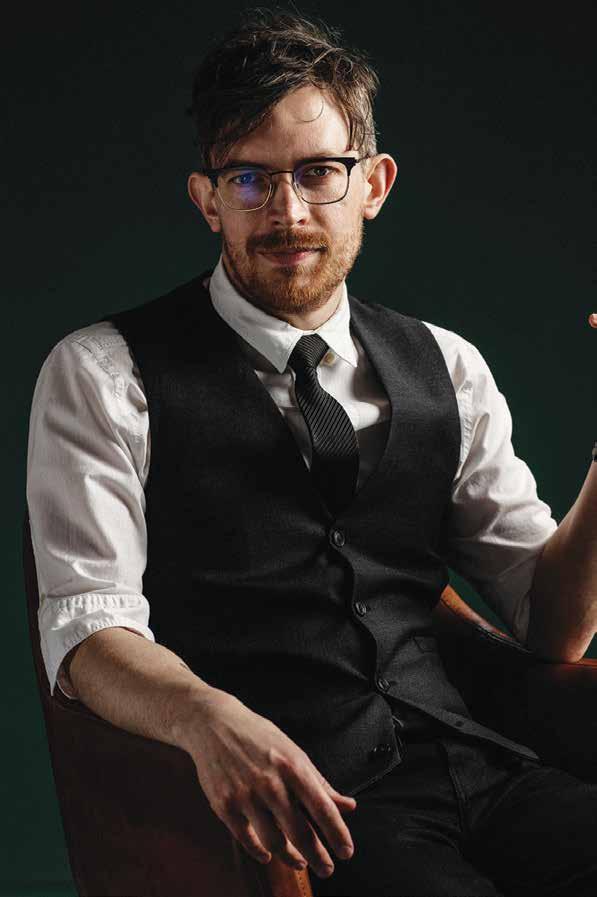
‘It’s difficult to explain, but working with gold somehow enriches my soul ’
pearl that takes centre stage for The Orb, where it’s set within a stunning 18ct rose gold ring that’s adorned with a liberal sprinkling of brilliant cut pink sapphires, orange sapphires, and green and pink diamonds. For the Pearl Hemisphere, another resplendent 14mm South Sea pearl is encircled by a sphere encrusted with pavé set brilliant cut rubies, which total 2.55cts. As a mark of O’Reilly’s innate creativity, that sphere is suspended by another, one open on one side and lattice-worked on the other. Dazzling. O’Reilly’s training in the world of precision engineering is overtly apparent. So to an ability to create extraordinary pieces that in some cases look like vintage treasures (look up the beautiful Blue Rose Signature and Rose Gallica rings), others, like the colourful Yukiko earrings, as though they belong in a distant future. Marvel at pieces like the Ad Lucem and Amun rings and note how his pavé setting technique is so skilled, the gradation
of coloured gemstones so remarkable, that it looks like the skin of an exotic animal. Little wonder his jewellery is more fittingly descried as wearable art. It's all a result of O’Reilly’s melding of ancient tradition and innovative technology. “I was trained by two German master goldsmiths – Erwin Springbrunn and Rudolf Heltzel – both of whom were in their 70s at the time, so modern technology didn’t play any part in their mentorship. But as my apprenticeship progressed, I began to understand how my engineering background could become useful in jewellery making. Everything I create is based on the traditional skills taught to me by these two masters, but I also use technology to help me push the boundaries of what can be achieved. There are no shortcuts when creating this quality of jewellery – your skill set has to be superb, but by combining that with technology, I can push myself and the end result even further.”
Skills aside, from where do the ideas


‘ I decided to get creative with my engineering skills to impress a girl I had a crush on ’
AIR for his novel designs spring? “My best work always comes when I’m listening to music and I just start drawing. I get into a state of play. If you take yourself too seriously, you can start to clam up. I bring my notebook everywhere with me and simply sketch, sketch, sketch. On paper, I can break down the components of a design and work out how they interplay. I think the greatest designs are those that come naturally.”
Feeling relaxed in his work is of real importance to O’Reilly, which is why his studio resides where he grew up in the west of Ireland, and not in a major city you’d readily associate with bespoke high jewellery. It’s to that studio in a town called Castlebar that clients are invited to discuss commissions. It’s also home to O’Reilly’s extensive collection of rare gems. “Sourcing gemstones is a very emotional experience for me. My former mentor, Erwin, was not only an amazing goldsmith but one of the best gemstone cutters in the world. During my training, I would watch him cutting gems – the love and passion he poured into each and every stone, and the precision he applied, was truly amazing. He would carry the rough stone in his top pocket, so that he could understand it and get ‘a feeling’ from it. He very much felt the stone would
reveal to him how it should be cut. Erwin passed away in 2015, but I’ve been lucky enough to be in a position to share his amazing stones with the world. As to what I look for in a stone? Beauty. I just look for beauty. Some people get caught up in the market value of stones. I don’t. I believe a piece of jewellery should be about more than its worth. It should have a story.”
It’s a story in which gold also plays a leading role. “It’s difficult to explain, but working with gold somehow enriches my soul. It has a magical property to it. Finding the right gem to match each shade of gold and creating something beautiful from the earth’s natural resources is truly magical.”
He describes the process of a creating a bespoke piece of jewellery with a client – which takes between three to six months, depending on the complexity of the design – as “challenging the client’s ideas. Exploring what can be achieved and discovering if we can both go on a journey together, to access different parts of our brains and imaginations. I want to make jewellery that looks beautiful, feels beautiful to wear and means something special to me and to the client.”
Which is fitting, as there’s certainly something special about Nigel O’Reilly.






Chanel’s couture atelier and the many tools it houses are the inspiration for a capsule collection big on creative boldness
WORDS: JOHN THATCHER




Gabrielle Chanel left a legacy that remains ripe with inspiration. Take, for example, her apartment at 31 Rue Cambon, which sits atop Chanel’s flagship Paris boutique and couture atelier in a charming 18th-century building. Though it is claimed that she rarely, if ever, slept here – her suite at the Ritz obviously too great a draw – it has been preserved almost exactly as she left it when passing in 1971; chockful of her treasured belongings, most notably her Chinese coromandel screens, but also a bounty of leather-bound books and decorative ornaments.
These myriad objects have proved fruitful stimuli for Chanel’s creative teams down the years, channelled into every strand of the brand’s output, fashion through to fragrances, jewellery to watches. Since 2017 it’s clocks that have sprung from this rich font of interior artistry, one such novelty, in 2019, even drawing inspiration from a bronze frog figurine that sat on a side table inside the apartment. At April’s Watches and Wonders, Chanel’s Watchmaking Creation Studio unveiled another; the marvellous Musical Clock Couture Workshop, a one-of-a-kind musical box, clock, and automaton of incredible detail and technical knowhow that sits on a plinth inspired by the apartment’s upholstered sofa. It also features a replica of a

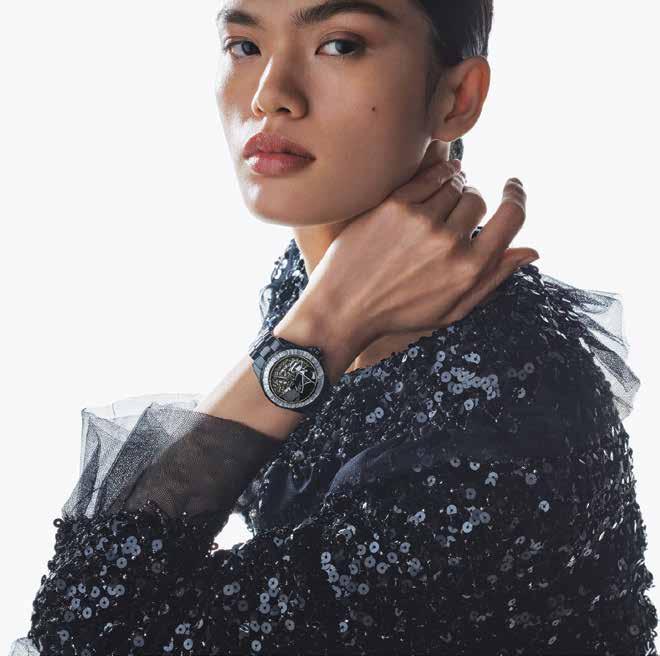
page, from left to right: Première Ruban Couture; Mademoiselle J12 Couture Watch Below: Première Ruban Couture Right, from left to right: Bust Long Necklace Couture; Safety-Pin Long Necklace Couture; Première Charms Couture
chandelier from the apartment, complete with diamond-encrusted droplets, under which five mannequins bob up and down as they rotate to the tune of ‘My Woman’, a melody that Chanel was said to be fond of humming as she worked. The clock is wound by a tassel-shaped key that takes its design cues from that used to unlock Chanel’s wooden security desk, and can be worn as a long necklace interspersed with pearls and diamonds.
The unique piece forms part of the Couture O’Clock Capsule Collection, which widens Chanel’s universe of inspirational objects to those that surrounded her in her Rue Cambon atelier – sewing needles, thimbles, scissors, pins, and spools of thread, the tools of couture, all of which have been reimagined by the Watchmaking Creation Studio to birth a collection of timepieces that perfectly encapsulates Chanel’s watchmaking savoir-faire. Divided into two parts, Mademoiselle’s Workshop and Mademoiselle’s Sewing Tools, the former features a thrilling tribute to both Mademoiselle Chanel and the watchmaking tradition of automata. “The J12 Couture Workshop Automaton Caliber 6 is a true technical tour de force,” states Arnaud Chastaingt, Chanel’s Watchmaking Creation Studio Director. Fashioned from 355 components, the new Caliber 6 (which was designed and


assembled by the Chanel manufacture in Switzerland) brings to life a cartoonstyle representation of Gabrielle Chanel, ringed by 48 baguette-cut diamonds and set against a five-tier dial devised to resemble her couture studio; intricate detailing that highlights bolts of tweed and camelia-print fabric, ribbons and spools of thread. At the push of a button, the figure of Chanel, dressed in her signature suit with scissors in hand, performs a rhythmic dance. At the same time, a couture dummy, draped in a partially finished black jacket, rises and falls on its tripod.
“It’s a watchmaking performance,” enthuses Chastaingt, who adds that “for the first time, the bracelet is in matte ceramic and the bevels of the links are polished to accentuate the interplay between matte and glossy black.” It’s limited to 100 pieces, a fact that’s stamped on its 8k-white gold and sapphire crystal caseback. The couture mannequin takes centre stage for the Bust Long Necklace Couture, one that’s crafted from 18k yellow gold and snow-set with 1610 brilliant-cut diamonds. Concealed at the mannequin’s waist is a black lacquer dial, its hands made of 18k yellow gold. Limited to 20 pieces, it hangs on a long chain studded with 32 brilliant-cut diamonds and one larger brilliant-cut centre diamond. The Mademoiselle J12 Couture

‘The beautiful Bobbin Cuff Couture draws design inspiration from a spool of thread ’
Watch comes in two guises: one limited-edition version with a matteblack-coated steel fixed bezel with black-varnished sapphire crystal ring; the other a 55-piece version, its steel with black coating fixed bezel set with 46 baguette-cut diamonds. The dials of both feature the same illustration of Mademoiselle Chanel set against a moving pattern of gold powderedprinted couture motifs. There are just twelve examples of another iteration, the J12 White Star Couture watch, a stunning combination of baguettecut white ceramics and diamonds.
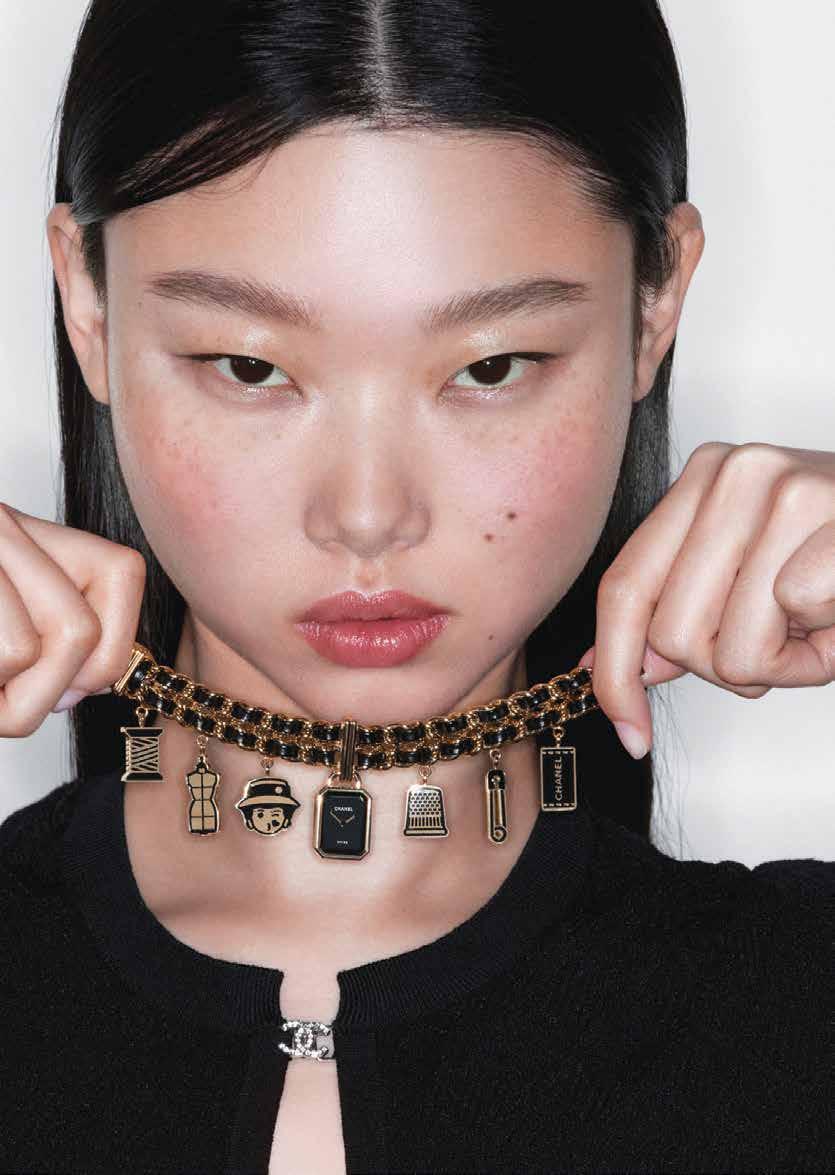
Mademoiselle’s Sewing Tools comprises its own set of striking timepieces, not least the beautiful Bobbin Cuff Couture. This unique piece draws design inspiration from a spool of thread, transformed into an 18k yellow gold cuff that hides a secret dial set with diamonds beneath an emeraldcut yellow sapphire. Elsewhere, a humble safety pin is adorned with snow-set brilliant-cut diamonds, an 18k-yellow gold watch dial set with 45 brilliant-cut diamonds nestled in its coil. It dangles from an 18k-yellow gold long chain that shimmers with 132 brilliant-cut diamonds and is limited to 20 pieces. There’s an element of the playful about the Première Ruban Couture Watch, its doublewrapped black and gold leather strap printed with the markings of a tape measure and its case enlivened with a single diamond-set charm. The same charm, a figurine of Gabrielle Chanel, also appears on the limited-edition Première Charms Couture Watch, where it’s joined by charms shaped a s various sewing tools and the instantly recognisable Première watch, affixed to a woven leather bracelet to reflect the chain of the classic Chanel bag. This a capsule collection that proves that when it comes to creativity, Chanel’s Watchmaking Creation Studio is the equal of its celebrated couturiers.

Kirsten Dunst talks movie industry predators, Tom Cruise’s kindness and her staunchest ally in the industry
Kirsten Dunst is on a sofa in the West End of London, but her body clock is still somewhere above the Azores. The 41-year-old actress has jet-lag – and is clinging to the upholstery as if for dear life. First thing this morning she was talking to the BBC, but en route to elevenses with me, she made a hotel pit stop to change from her more glamorous oncamera attire into a comfortable black blouse and trousers.
“I am going. To make. A cup. Of TEEEEEEEEA,” she says, very brightly and deliberately, and shuffles over to the kettle on the sideboard.
The star of Spider-Man, Marie Antoinette and Melancholia – about as wide-ranging a CV as the laws of spacetime allow – left her two boys at home in Los Angeles with their dad, the Killers of the Flower Moon actor Jesse Plemons, “and I boarded my flight to London thinking ‘way-hey!’ Then we landed, had our screening, all went out together for a nice dinner. And now…” She makes a long croaking noise, that


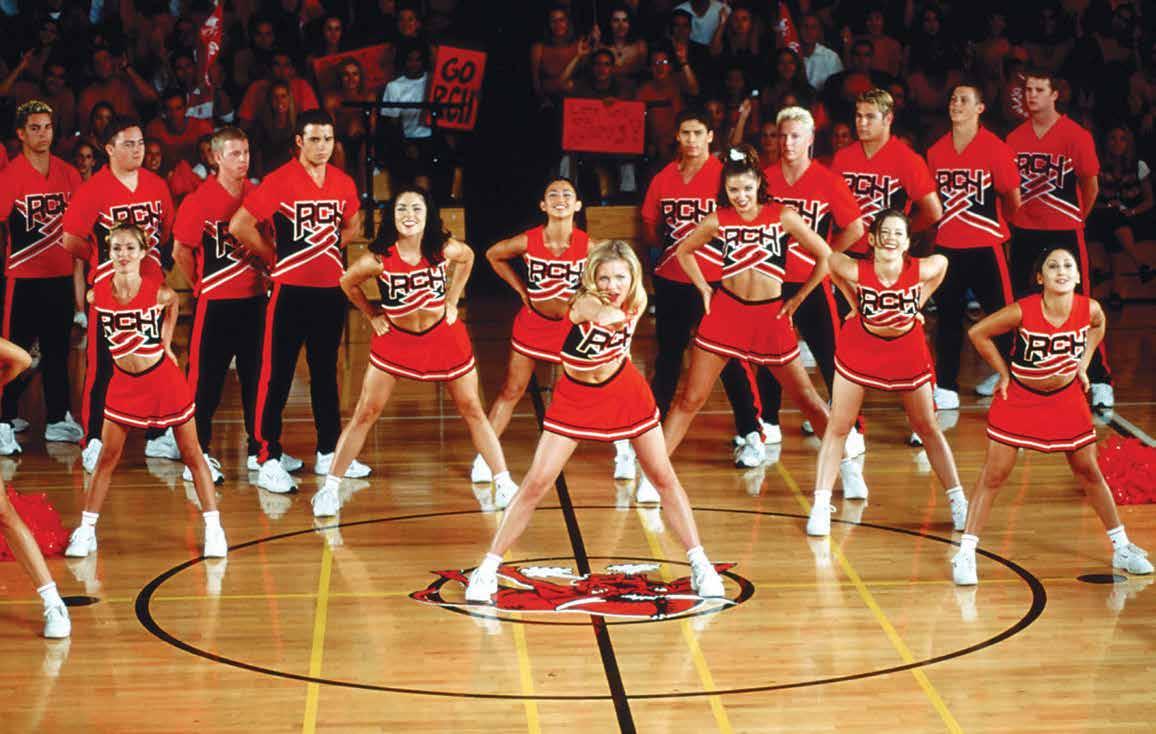
‘ I remember sitting there and knowing that something was wrong, but with no idea what I should do ’
sounds like a frog.
Not that her three-year break has been time off. Dunst gave birth to her second son James in May 2021 – who was conceived on the evening of the wrap party for her and Plemons’ first film together, The Power of the Dog. And nine months after that, she was filming her most recent movie release, Civil War, in Atlanta, with James’s older brother Ennis, now nearly six, sometimes visiting the set. Even so, Civil War marked the end of Dunst’s longest break from our screens since the former child star was her eldest son’s age.
Written and directed by Britain’s Alex Garland, of 28 Days Later and Ex Machina, Civil War is the wildly thrilling and sickeningly plausible thriller about the violent nearfuture collapse of the United States. Dunst stars as Lee, a hard-nosed photojournalist who makes her way through scenes of surreal carnage and chaos.
As hinted by her name, her character was partly inspired by Lee Miller, the fearless model turned combat photographer who was famously snapped in Hitler’s bathtub during a 1945 assignment in Munich. But Dunst also drew inspiration from the war correspondent Marie Colvin, who was killed in Syria by Assad’s forces in 2012. What struck her most, Dunst says, “was that there was zero look-at-me in her. Zero. She did her job because she had to, and that was all there was to it.”
The hardships of war zone survival are worlds apart from Dunst’s own
august career in cinema, which took her from Best Kiss at the MTV Awards (for Spider-Man) to Best Actress at Cannes (for Melancholia) in the space of eight years. But as a former child actress who shot her first breakfast cereal advert at the age of three, she spent her first two decades navigating a very different sort of treacherous landscape.
Her early start in acting was thanks to her mother Inez, a former Lufthansa air stewardess whose own un-pursued showbiz ambitions were nudged down a generation when strangers kept telling her how uncommonly bonny her daughter was. Dunst’s parents separated when she was ten, after which she moved with her mother and her elder brother from New Jersey to Los Angeles.
Back in the Spider-Man days, Dunst sometimes rued her mother’s pushiness. Right now, however, she’s just thankful that Inez was as committed to her daughter’s safety as she was her success.
“I was only able to avoid that predatory side of the business because wherever I went, my mother was literally always right there.”
When Dunst starred alongside Tom Cruise and Brad Pitt in Interview with the Vampire at the age of 11, she was “treated like a princess. Yes, it was a virtually all-male set, but everyone was very gentle and kind, and nothing ever felt weird. Brad was like an older brother to me.” (Notwithstanding their characters’ on-screen kiss, which a preteen Dunst once famously described as “gross”.)
“And then Tom – well, one morning around Christmas I remember going into my dressing room at Pinewood and he’d set up a beautiful tree in there for me, covered in ornaments.”
Her brush with the industry’s dark side came a few years later, when she was 16, and found herself in a very awkward conversation while auditioning for a sought-after role. “A male director had me in his office, by myself, and was asking me about this movie he wanted me for, and then, completely out of the blue, asked me this inappropriate question,” she recalls.
She declines to elaborate, or to name the culprit. “Honestly, I’m not even sure he’s still working any more,” she says. “It’s not something I like to reflect on. But I will say what he said was nothing to do with acting. And it wasn’t that what he said was just ‘a bit off’. It was totally improper. And I remember sitting there and knowing that something was wrong, but with no idea what I should do.”
After the audition, Dunst told her mother what had happened, “and that was the end of it. She withdrew me from the process and told them I wouldn’t be making the film.”
In the years ahead, an unflinchingly businesslike attitude became Dunst’s go-to tactic for staving off such unwanted advances. “I don’t give off that vibe,” she once told Sofia Coppola when the director asked if one of her male counterparts had ever “pounced on” Dunst on set.
In fact, it was meeting Coppola in her mid-teens, during the casting of 1999’s The Virgin Suicides, that gave her one of her steadiest friends and staunchest
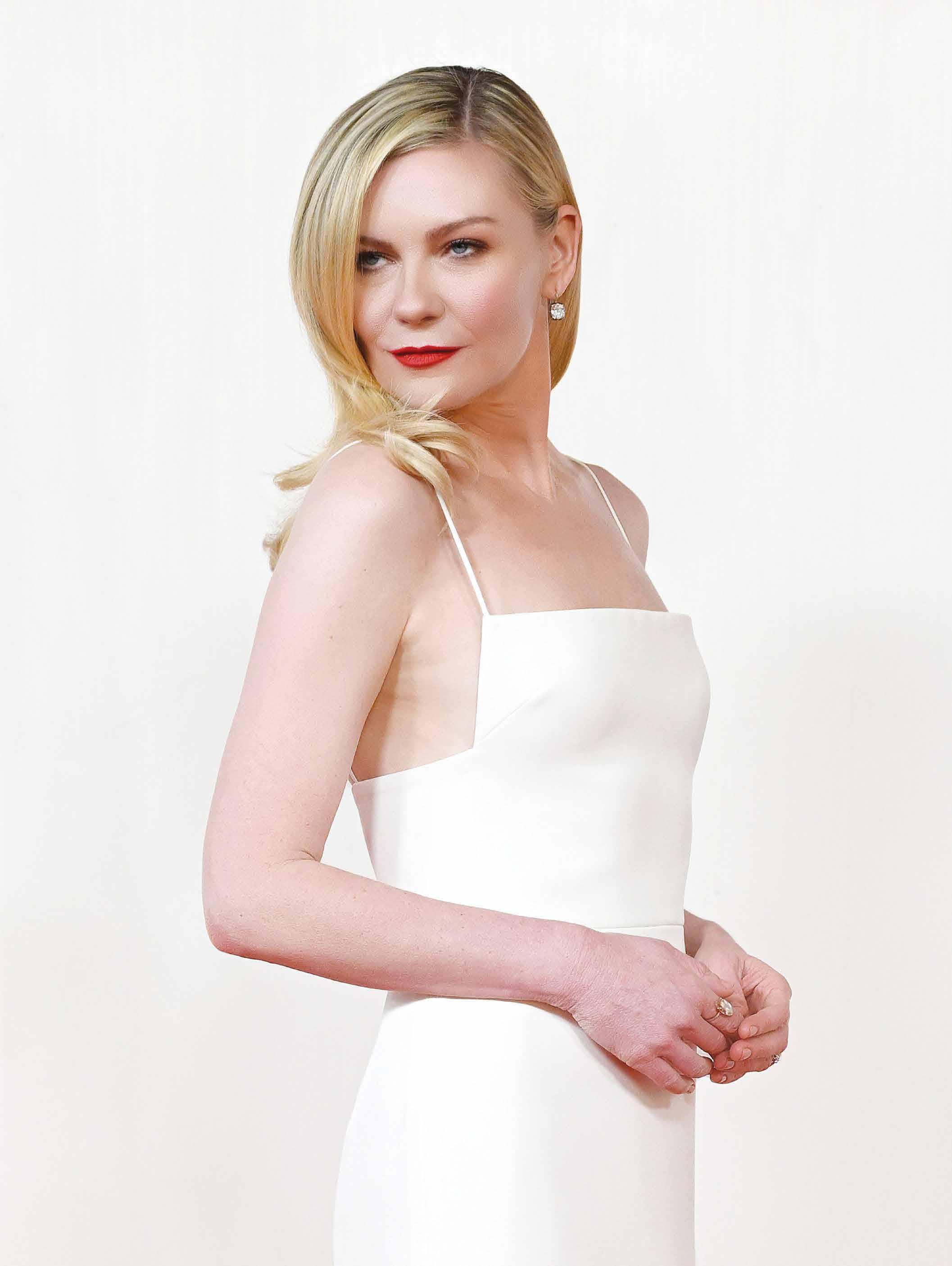

‘ I had no awareness of the fact that I was being paid much, much less than my co-star and that it might be unfair ’
allies in the business.
“The way Sofia made me feel about how I looked on camera gave me so much confidence in my teenage years,” she remembers. “It’s a weird age to be working in Hollywood, and I know how rare and valuable it is to find that kind of mentor.” The pair made two more films together after that, Marie Antoinette and The Beguiled
She also credits Coppola with instilling the confidence to turn down the various industry types who in the years ahead tried to persuade her to straighten her teeth – including a Spider-Man producer who had her physically driven to the dentist when she was 19 years old.
On that occasion, she refused to get out of the car, her natural smile survived – and of course, the film was all the better for it. Dunst’s Mary Jane Watson might have been countless millennial males’ dream teen crush, but the fact she wasn’t an impossible pin-up gave those early Spider-Man films a very human sensuality and warmth.
“All I can say is that when I was 19, I was not thinking in those terms at all,” says Dunst of that time.
Dunst has been around for long enough to have seen Hollywood repeatedly shape-shift, but since the Spider-Man days, has anything meaningfully changed?
“The one big thing is the more open conversation around women’s pay,” she says. “When I was cast in Spider-Man,
I had just had this big hit with Bring it On – so, you know, I was actually bringing something to the table. But I had no awareness of that, nor even that the fact I was being paid much, much less than Tobey [Maguire, her co-star] might be unfair. So it wasn’t as if I was turning up to the set every day feeling bad about it. It was just something noone even thought to question.”
Nor did she bristle when the crew referred to her on set – affectionately if demeaningly – as “girly-girl”, rather than by name.
Her first inkling that something might be amiss came during the promotional campaign for the sequel. “They put out the poster, and mine was the only visible face on it, because Tobey was in costume. And I was like, ‘hang on a minute, I’m a selling point.’”
The first flush of stardom that followed was, she says, “unusual, in that I was still discovering who I was as I went along”. There was a whirl of celebrity boyfriends, including Jake Gyllenhaal, Garrett Hedlund and Razorlight frontman Johnny Borrell, as well as roles in huge romantic comedies like Wimbledon and Elizabethtown.
Indeed, it was her character in the latter that prompted the critic Nathan Rabin to coin the term ‘Manic Pixie Dream Girl’ to refer to the quirky-butbeautiful young female love objects that had started cropping up everywhere in noughties American romcoms.
“But I was never happy playing ‘in
love’,” she says. “I hate it. It’s so boring. There were so many of those films being made at the time, and I did quite a few of them – and the non-traditional spins, like Eternal Sunshine of the Spotless Mind, those were great. But the roles I felt unhappy with were the ones that f elt contrived.”
Ironically, it was while playing one half of a married couple that she met Plemons, who in 2015 was cast as her husband in the second season of the dark comic thriller series Fargo. As Peggy and Ed Blumquist, two eccentric Minnesotans who get caught up in a criminal turf war, the two had obvious chemistry, and Dunst describes their relationship as “falling in love creatively first – it’s having that feeling of freedom when you’re acting with someone that they’re so in the moment with you that it wdoesn’t feel like you’re acting at all.”
They got together the following spring, but until recently had only acted together again one more time, for Jane Campion in The Power of the Dog, from which his-and-hers Oscar nominations resulted.
But after one of Civil War’s original cast had to drop out from a small but crucial role – a psychopathic loyalist soldier Lee and her colleagues meet on the road – Dunst suggested her other half as a possible replacement.
“I mean, it was an irresistible deal,” she laughs. “No additional hotel or transport costs. Plus he is very good.” Didn’t she find it strange or uncomfortable being tormented by a loved one on camera? “I honestly didn’t think of it like that,” she shrugs. “Acting’s acting. It doesn’t all come from within. He’s one of the kindest people I know.”
She’s proud of Civil War and hopes it got people talking, although notes that this is the first time one of her personal favourites was met with a largely positive wave of reviews. The Virgin Suicides and Marie Antoinette, her films with Coppola, took a while to become cult classics.
But usefully today’s tastemakers are the kids who once thrilled at that upsidedown kiss, and had Bring it On posters Blu-tacked to their bedroom walls.
Does that worry her? “Maybe it should,” she laughs, after draining her last drop of tea. “But I’m enjoying not having to tell myself, ‘They’ll like this later.’”

Men of distinction have long turned to Dunhill for tailoring, and with a new creative director at its helm, more will be following suit
WORDS: STEPHEN DOIG
Bourdon House, a stone’s throw from Berkeley Square in London, may be set amid the throng of 21st-century Mayfair – tourists taking selfies outside Louis Vuitton, and Annabel’s club dismantling its latest eye-popping display – but the mood here is completely different. Beyond those glossy black doors –the very ones that greeted the Duke of Westminster when he lived here – there’s a private member’s club so discreet it would never deign to divulge its fees, all plush burgundy interiors and patrician dress codes. But it’s upstairs that the real action takes place.
Unlike most tailoring emporia, whose studios tend to be below street level, Dunhill’s bespoke and made-to-measure operations have their nerve centre on the upper levels of Bourdon House. It’s a few modest rooms where canvas sheets dotted with the small print of each bespoke jacket and pair of trousers line the rails, and a whiteboard charts the progress of each item through the system, and for whom it is destined –a sort of sartorial war command. Its lofty position within Bourdon House means light streams into the warren of rooms, ready for Dunhill’s new life under recently installed creative director Simon Holloway (pictured).
“There’s a sense of responsibility in looking after the heritage of a house like Dunhill, and its future trajectory,” says Holloway. French conglomerate Richemont – which counts Cartier, Van Cleef & Arpels and Alaïa as its crown jewels – bought Dunhill in 1998. Holloway, who cut his teeth at Calvin Klein and Ralph Lauren, was ushered across from historic British outfitter James Purdey & Sons, also owned by Richemont, in April 2023.
“But I like to think that Alfred Dunhill would approve of the direction we’re taking things,” says Holloway, who replaced former creative director Mark Weston, and before him John Ray, previously Gucci’s head of menswear. It’s fair to say there have been a few ups and downs in the past 15 years, but Holloway’s focus is Dunhill distilled: homing in on the immaculate tailoring that’s been a sleeper hit at the house, which has been better known for sporting attire and accessories.
“We’ve seen a significant uptick in suiting sales, and I think that comes

‘ There’s a sense of responsibility in looking after the heritage of a house like Dunhill ’
down to the pendulum swinging back to a more tailored silhouette from a fashion perspective. I think people have casualised to the point where they’re actually bored of slumping around,” says Holloway. His first focus on arrival was the house’s bespoke arm, enlisting Savile Row’s secret weapon, William Adams – a tailor who’s worked at some of the finest houses, including Ede & Ravenscroft and Kilgour – to run the tailoring department and execute Holloway’s vision of sophisticated, elevated suiting. The Bourdon House nerve centre comprises three cutters, one trouser
maker and two coat makers – this last being the traditional term for the complex craft of constructing a suit jacket. The focus here is on excellence of fabrication. First a client will sit down to have a consultation in one of the handsome rooms that mushroom off the central staircase, and to leaf through fabric swatches, particularly those from British mills; Adams gestures to an inky expanse of navy pinstripes destined for a single-breasted suit. The process involves conferring with the tailoring team on the minutiae of fabric, style and fit – anywhere between one and three meetings to fine-tune the details,

although repeat orders can be placed from anywhere in the world so long as Dunhill has your measurements. Once the form and structure are decided upon – single-breasted or double, dinner jacket or something sportier – the whole process will take up to 10 weeks; costs depend on choice of fabric and details, but expect a substantial four figures.
The most adventurous garment that the bespoke studio has worked on to date was a fleece coat with a difference – the polyester fabric replaced by cashmere, and the nylon accents by suede. As a rule, though, this is the place to come for exceptional bespoke suits for events and serious business meetings. They’re working on up to 80 suits at any one time.
“I wanted to refine the sense that this is the pinnacle of British craftsmanship and the feeling of handcraft and a careful curation,” says Holloway of his interpretation of Dunhill’s tailoring. Connoisseurs can spot signature stylistic flourishes a mile off: the soft drape of Anderson & Sheppard, the peak lapels of Edward Sexton. What does Holloway intend for Dunhill? “It’s going to be a masculine silhouette,” he says. This will be welcome; after years of blowsy, oversized shapes at Zegna and Versace, or reed-thin, gender-fluid cuts at houses such as Celine and Saint Laurent, the proportions of men’s suiting haven’t favoured plain old ‘classic’ for a while. “Structure but with lightness, a very British look, and fabrics with a very English colour palette and texture,” says Holloway, who worked with historic yarn makers in Hawick, Scotland, to formulate particular cloths. “There’s a sense of Britishness at Dunhill’s core.”
Dunhill, one of the few British-born luxury houses, has perhaps more than most always been about innovation and doing things with pluck and gumption. Alfred Dunhill was a pioneering young fellow who started as an apprentice at his father’s saddlery business aged 15, and took the reins in 1893 at 21. As technology changed, he responded by outfitting the new world of automobiles, creating, as he termed it, “everything but the motor.” A raffish young Bertie Wooster could have seen his Morgan accessorised in Dunhill’s leathers, had Jeeves pack his white tie in its debonair suitcases and – by the roaring twenties – lit his cigarettes with a Dunhill lighter.

‘ I think people have casualised to the point where they’re actually bored of slumping around ’
In a sense, the Dunhill man has always cut a rather glamorous dash. To opt for a Dunhill suit was to actively choose something more racy over the rather staid Savile Row; sports jackets, driving accessories and eventually a rakish line-up of eveningwear came to be its calling card. Fleming’s Bond was fond of its lighters, and Truman Capote donned Dunhill black tie for his 1966 black-and-white ball. Back in the eyrie above Bourdon House, the tailors are focused on the finer details of the robed effect on a shoulder, or the alignment of stripes on a lapel. "It’s important to try and thread a needle through an entire century plus of Dunhill in this new era," says Holloway. The trusty suit is a solid place to start.



In 1990s New York, photographer Dafydd Jones roamed the city by day to capture life at street level. But at night he was asked to infiltrate the world of the elite and the influential, capturing their antics at some of the city’s most lavish parties
WORDS: CHRIS ANDERSON
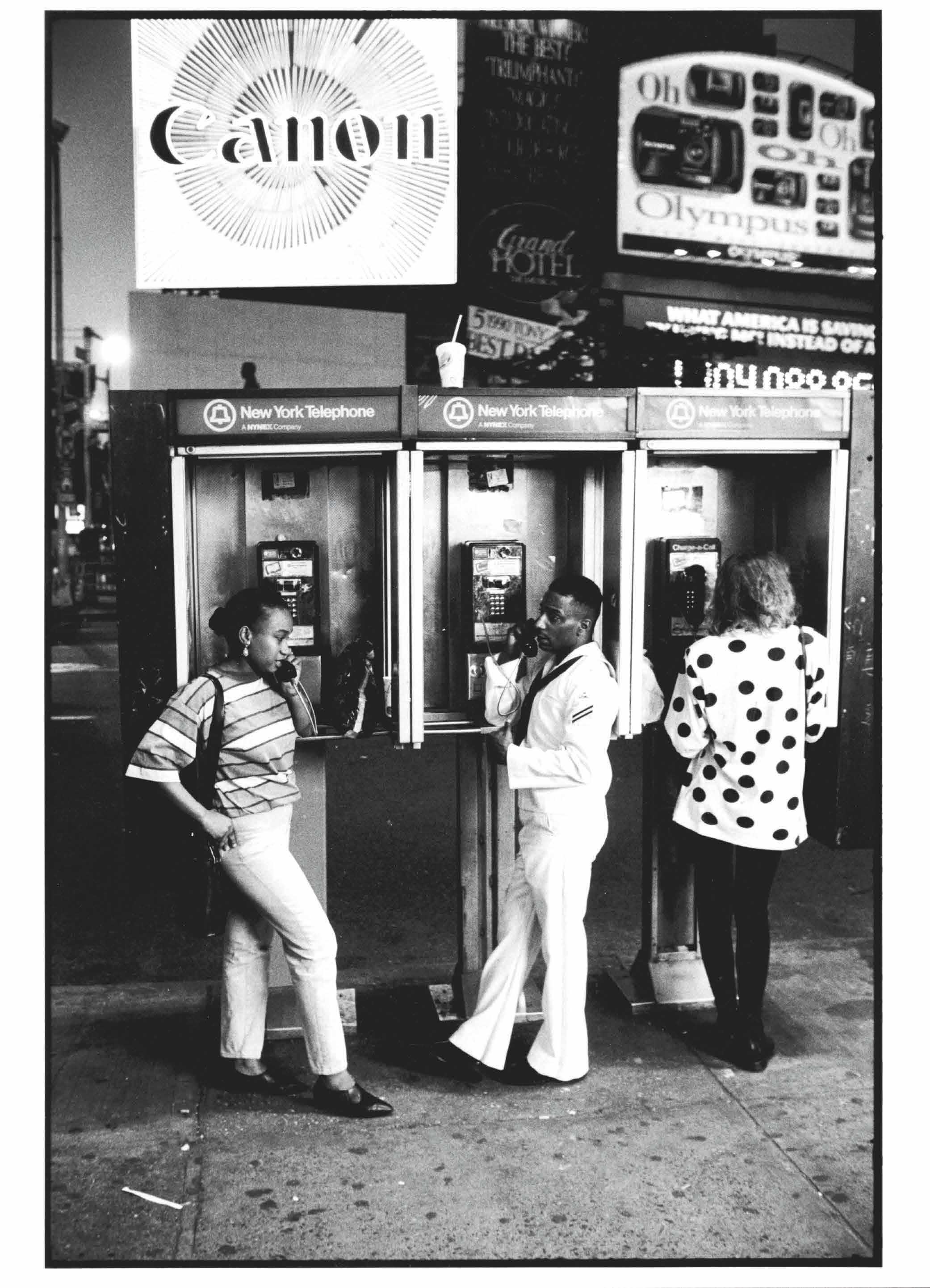

There is one image that stands out as a quintessential embodiment of the audacity, opulence, and subtly surreal nature of Welsh photographer Dafydd Jones’s New York nighttime adventures during the 1990s – so much, in fact, that it features on the cover of his latest book, New York: High Life/Low Life. The shot, taken at an event in 1990, shows archaeologist Iris Love and socialite Brooke Astor both holding dogs, caught unawares as a tray of pup-friendly canapes enters their vicinity, with both animals launching themselves in its general direction. The occasion was a dog-and-owner party held for the city’s elite at Barbetta restaurant, with a caption accompanying the image in print that read: “Iris Love, Just Desserts, Brooke Astor, and Dolly Astor at a dachshund party.” Yes, even the dogs were named. Having returned to the UK many years since, and speaking from his studio in East Sussex, Jones is quick to elaborate. “I was working for Vanity Fair at the time, and my job was to head out at night and document the city’s social scene,” he says. “I photographed everyone, from
‘Trump seemed a bit of a loudmouth, and I could see that the New York aristocracy looked down on him’
businessmen to celebrities, socialites to politicians, even royalty, and there would be these huge parties and gatherings. But there was a rule: if you didn’t get the names of everyone in the photo you took, it couldn’t go in the magazine’s social pages. It wouldn’t even matter if it was a great picture. So with the image of the ladies and their dogs, I got everyone’s names, including Just Desserts and Dolly!”
Looking through the book, there are many recognisable faces, caught either inside a venue or emerging from their stretched limousine. Arnold Schwarzenegger, Sharon Stone, and a fresh-faced Johnny Depp with thengirlfriend Kate Moss were among those in the public eye at the time, while John Galliano, Jean Paul Gaultier, Karl Lagerfeld, and Gianni Versace, also pictured, ruled the fashion world, as did supermodels Claudia Schiffer and
Naomi Campbell – Jones has included an image of a beaming Campbell taken at her 20th birthday party. Other photos, meanwhile, depict figures that register in the current news cycle, including Joe Biden and Donald Trump. According to Jones, Trump was a dominant figure on the New York social scene, attending parties and hosting his own. “I didn’t ever take Donald Trump seriously,” Jones says of the former US president. “The first time I photographed him was at a funeral, and he came with a bodyguard, which I thought was strange. To me, he seemed a bit of a loudmouth, and I could see that the ‘old money, old New York’ aristocracy looked down on him.”
But Trump did indirectly create one of the more striking images in Jones’s book, showing ex-wife Ivana Trump sat with her head in her hands at a Plaza Hotel fashion show. “That was taken in the middle of their divorce, which was playing out as a kind of soap opera in the New York Post and the New York Daily News, the two rival tabloids,” Jones reveals. “Ivana was smiling for the cameras, but then for a second it became too much. But I guess that was what my editors were
Opening pages, from left to right: Tommy Bancroft, fancy dress party. Manhattan, July 1990; Times Square during Fleet Week, 1992
These pages, clockwise from left: Front row applauding Carolyne Roehm’s spring collection. Jerry Zipkin, Nan Kempner, Annette Reed, Judy Peabody, Henry Kravis, Chessy Rayner, Mica Ertegun, Pat Buckley. The Plaza Hotel, 1989; Ivana Trump (in the middle of her divorce from Donald Trump), Fashion Group couture show, The Plaza Hotel, 1990; Maria Paterno Castello di San Giuliano, Princess Asaea Beatrice Reyna di Savoia, Miss Hikari Ohta, and the maid, chatting in the ladies powder room during the International Debutante Ball. The Plaza Hotel, New York, 29 December 1993
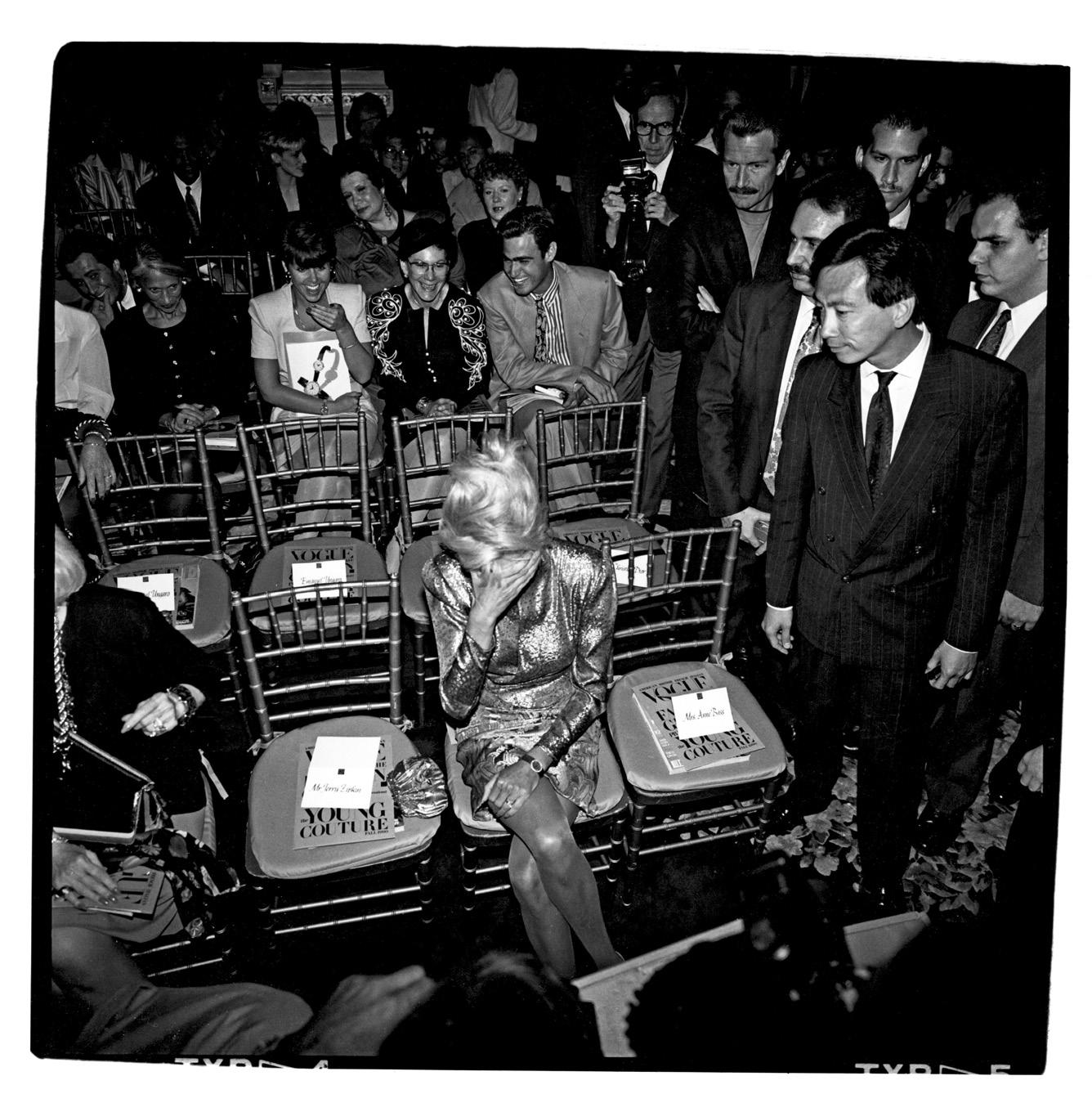



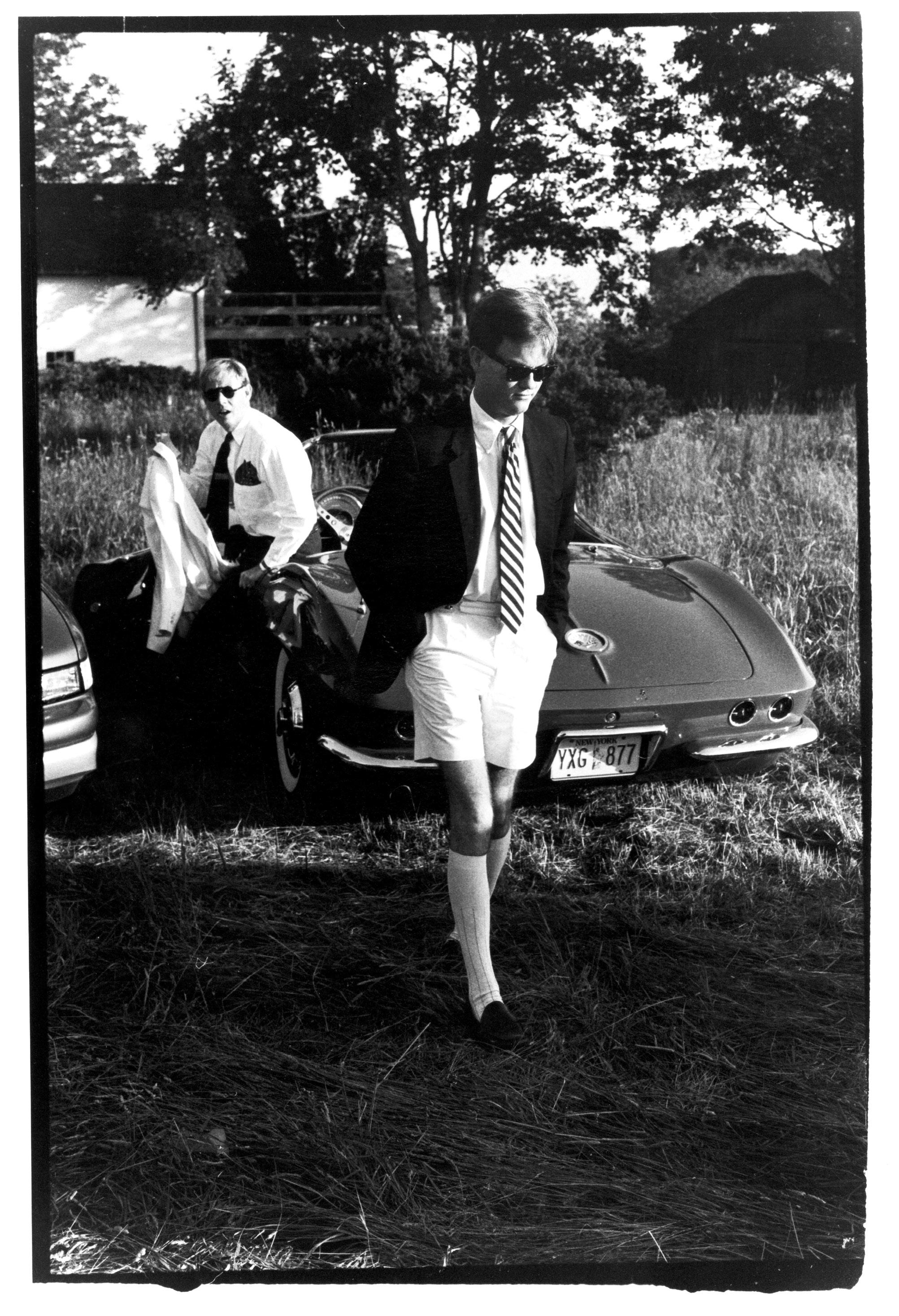
Previous pages, from left to
These
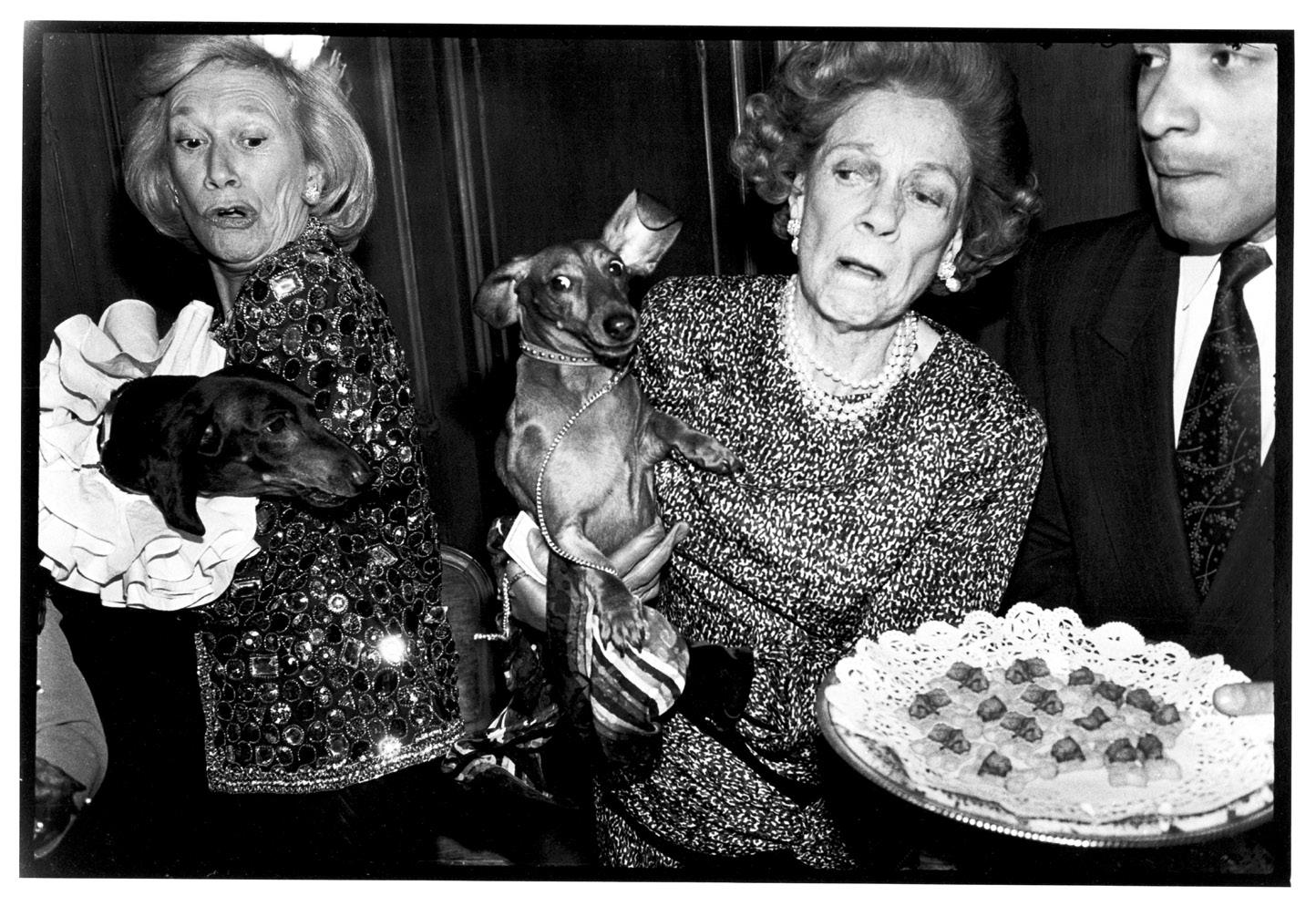
‘ The rule was if you didn’t get the names of everyone in the photo you took, it couldn’t go in’
looking for. They ran the Ivana picture on its own on the front page of the Vanities party section in Vanity Fair.”
Notably, all of Jones’s images are in black and white, which the magazines at the time preferred, having yet to switch to full-colour printing, and it was also the photographer’s personal preference. Through these varying shades of grey, Jones was able to capture the pomp and grandeur of 1990s New York. He was also willing to be creative on occasion, climbing a water tower to get an overhead shot of a rooftop party at the Peninsula Hotel, with the city skyline as its dramatic backdrop, and finding leaning fire hydrants and life on the streets another source of inspiration. But nothing impresses more than Jones telling stories of the characters he met. “You’ve got the photo of socialite Martha Reed at a gala, holding her personal Tiffany twizzle stick, which she used to pop the bubbles in her champagne,” he says. “And in
another, Tommy Bancroft, businessman and owner of many stakes-winning horses, stepping out of his limo in full regal attire. We couldn’t get permission to photograph the party he was going to, but someone in the office knew where it was happening, so I waited outside and would snap people as they were going in.”
And there was the time he took a boat trip with actor Paul Newman. “That was for a party on Liberty Island, where the Statue of Liberty is,” Jones recalls.
“There were lots of interesting people there, and in the photo I took of the journey over you’ve got Paul Newman, Natasha Richardson, and Lauren Bacall. All no longer with us. But the boat ride was the best part for me, as it was a summer evening and still light, and quite dark inside the party itself.”
Photographing the high life of New York was an experience Jones remembers fondly, having moved to the US with his family after eight years of working for Tatler magazine in the UK,
again with a focus on social occasions.
“I loved living there,” he says of the States. “There was something going on all the time, and photographing parties is a narrow speciality. I did enjoy them. And in the 1990s, there was a surge in demand for pictures of parties and celebrities, so lots of people were doing it, and you had magazines springing up that only featured images of social events.”
Soon the UK began calling, and Jones and his family returned home, with the photographer still working today. “I’ll go to openings and launches, and I’ll cover private parties, but less so for magazines,” he says. “And I’ll shoot in colour.”
The location may have changed, but the essence of Jones’s artistry remains. His images are a testament to life’s most luminous moments, wherever they may unfold.
New York: High Life/Low Life by Dafydd Jones is published by ACC Art Books


E“ngineered for real drivers” is the launch slogan for the new Aston Martin Vantage, a bruiser of a two-seat coupé. It’s the sort of hokum that marketing executives come up with when they think no one is looking.
If this new car is as billed, then what on earth were they doing with the previous generations of the Vantage, or what, for that matter, has anyone at the company been doing in its 111 years of existence?
At the same time, with 656bhp and 590lb ft of torque squirted to the road via the rear wheels only, I’m wondering whether I’m a real enough driver to control this machine. I’m barrelling along at 260km/h with the twinturbocharged V8 engine yowling in the morning sun on the 960m main straight at the challenging Circuit Monteblanco near Seville, preparing for the big braking moment into the first, surprisingly tight, righthand corner. I remind myself that this is the ‘starter’ Aston, a name first used 74 years ago on a 125bhp coupé; where did it all get so fast?
As I walked into the pitlane, the harsh light pinged off the example painted in the same green as the F1 racer and I gasped. Unlike its predecessor, this is a cracking looking car; even the reflective highlighting around the grille and the sills only serve to emphasise the lines (especially on darker colours) rather than being crassly nouveau as it was with the old model. The balance is just right between old and new, though the egg-crate grille will have you reaching for your Book of Aston Martins to check its provenance. I guessed something from Frank Feeley’s back catalogue, a DB3S maybe, others a V12 Zagato. Either way it looks absolutely right and not at all a retro-inspired afterthought.
As far as the chassis is concerned, the previous car’s aluminium architecture has been completely re-engineered, though the supercar-standard double wishbone front and multi-link rear suspension are retained. There’s new upper and lower cross-bracing for the front and rear to improve the accuracy of the wheel response and new damper top mounts for the same effect.
Bear in mind that in the previous Vantage F1 the Mercedes-AMG V8 was pumping out 527bhp at 6,000rpm and 505lb ft of torque at 2,000rpm. This
‘ You can draft this car along with astonishing velocity, but a completely unhurried feel ’
car produces 656bhp at 6,000rpm and 590lb ft at 2,750rpm.
What Simon Newton, the director of vehicle performance calls “the crescendo effect” is presumably what I’m feeling as this car monsters along the straight at 2.7 miles per minute.
I’d been a bit concerned about this amount of power in a rear-drive-only car; the prospect of getting it badly wrong at such speeds is terrifying. For what else would you call something capable of 325km/h and 0-100km/h in a mere 3.5 seconds? And yet it’s nowhere near as unnerving as Newton’s slightly scary presentation had posited. The steering is all you’d expect from an Aston Martin: gentle in its response with good weighting and superb oncentre response so that before you turn into a corner you instinctively know how the car’s going to react. Similarly, the throttle response, which is progressive and accurate, so there’s never a sense of the AMG engine
running away with you. It produces a nice noise, too, not guttural as of old, but an insistent and urgent throaty report of pistons bouncing in their cylinders.
I’m enjoying the gearchange, too. There’s an almost instant response with never an iota of slip or slop, without the brutality and lack of mechanical sympathy of some rivals’ gearboxes. And that’s even with the Sport+ mode selected. In fact, the most extreme Track setting was too much on the bumpy circuit and even Newton admitted that he preferred the penultimate setting of Sport+ even when going fast.
Cars that are good on a racing circuit seldom turn out to be much cop on the road, but we were in for a lesson. The allnew interior features revised sweep lines for the door and fascia panels and small screens for the touch functions in the centre, along with a mildly customisable digital panel for the instrument binnacle. It’s all rather small and a bit pokey, but that doesn’t seem to matter much. The satnav is clear, the push buttons aren’t too hard to fathom and the speed and engine revs are immediately apparent.
Seats for the circuit run were the optional carbon-fibre buckets, but they weren’t easy to get in and out of. The less extreme standard
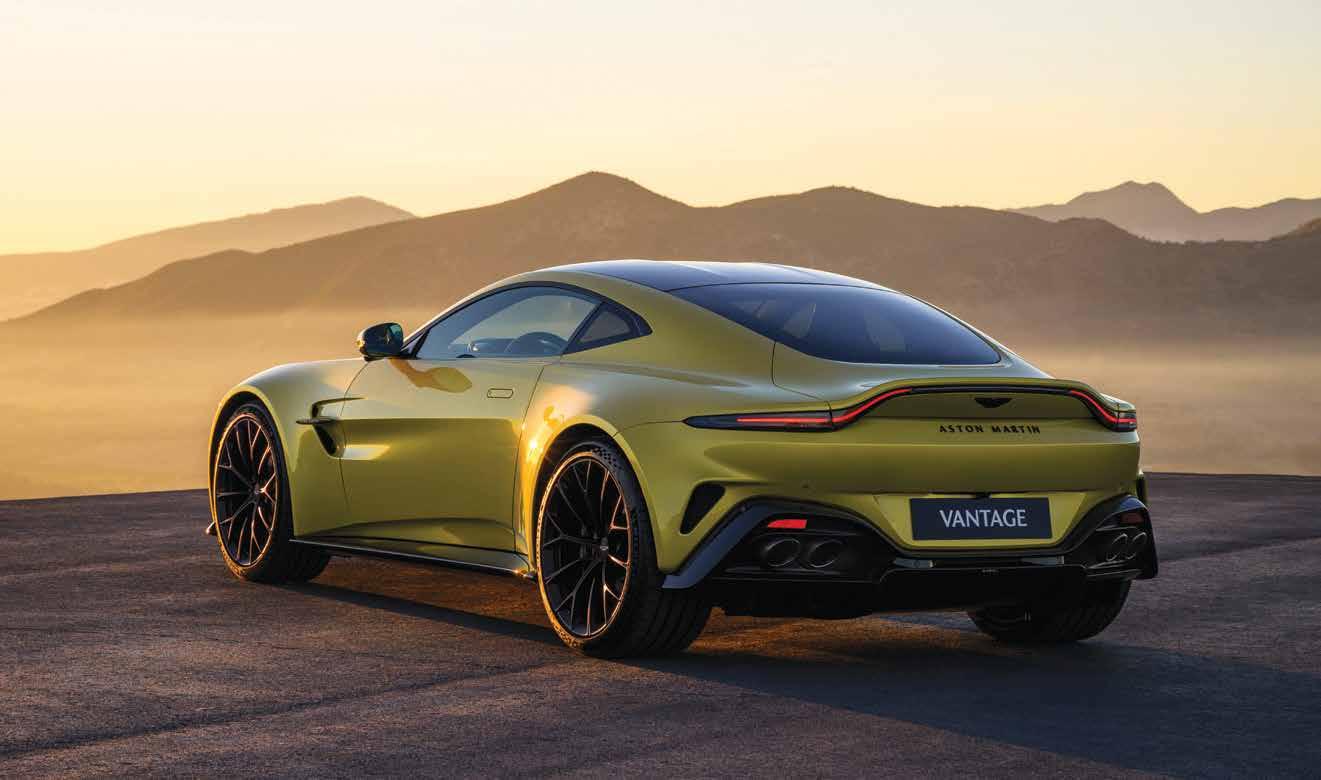
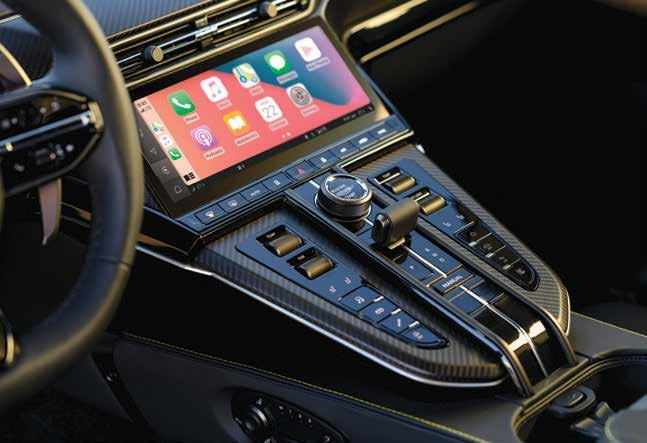


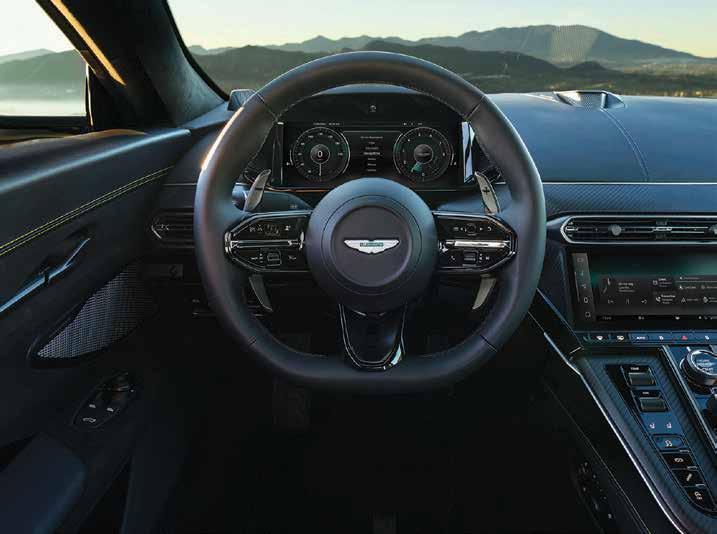


leather seats were altogether more comfortable and cossetting. Using the engine’s formidable torque, you can draft this car along with astonishing velocity, but a completely unhurried feel. The amazing steering response allows you to push through a turn in perfect control and with enormous confidence, but this is far from an “all power and no finesse” machine. The brakes can be used gently and progressively and the driving experience is so intuitive that there’s an almost sixth sense imparted by the Vantage. On a couple of occasions, there was a hazard hidden around a corner, yet when encountered there was no sense of drama, just a timely brake and evasion, no problem.
As you’ve probably gathered, I thought this car was rather special. You might say it needs to be, given the parlous state of Aston’s finances in the wake of its stock exchange flotation. Naturally, the extra power is lovely, but the dialling down of the bodywork drama along with painstaking attention to chassis detail count for more. Aston Martin has created a car the Vantage should have been in the first place; a proper grand tourer with genuine cross-continental abilities and luggage space combined with sophisticated chassis balance.


It’s not obvious from his appearance – like most top chefs these days, he cuts a slim figure – but beneath the pristine chef whites that bear his name, Jean Imbert must have broad shoulders. How else could he carry the likes of Plaza Athénée, Venice-SimplonOrient-Express, and Dior, all iconic names for whom Imbert heads culinary concepts. Throw in the legendary Le Brando hotel, Hôtel Cheval Blanc StBarth, and the Dorchester Collection’s debut Middle East outpost, The Lana, and the number of luxury brands that place their trust in Imbert’s irrefutable talent add up to a hugely impressive list.
It’s at the latter of those hotels where I meet Imbert one early morning in May, chef whites already on as he takes a seat in Riviera, one of two outlets he fronts at The Lana. I want to know how he handles the pressure – if he even feels pressure – from overseeing so many places for so many brands across the globe. But first, I want to know where his obvious drive to do so stems from.
“It’s weird, but one of my earliest memories is this feeling of wanting to go into the kitchen and cook. My mum tells me I was aged around five or six when I’d say that was what I wanted to do.”
And what was it he made? “I don’t remember exactly, but I know it wasn’t a dessert. The idea was always to create a big meal to sit at the centre of the table. When young people tell me they want to be a chef I ask them what it is that they like to cook. If they tell me something like chocolate cake I tell them they’re not going to be a chef. I wanted to make a real dinner, not a cake for fun.”
Imbert doesn’t elaborate on this point, but it’s obvious that a love for creating dish after dish, and the hard work that entails, are central to his thoughts.
While budding cooks now seek advice from Imbert, it was revered French chef Paul Bocuse from whom Imbert gleaned knowledge, a man dubbed ‘the Pope of gastronomy.’ Imbert studied at the esteemed Paul Bocuse Institute aged 17 and is in no doubt of the late chef’s enduring legacy. “I don’t know if the young generation understand quite how much he impacted French cuisine.”
In 2012, five years on from studying at the Lyon-based Institute, Imbert was crowned the youngest ever winner of TV show Top Chef, and soon after opened his first restaurant, a bistro, in
Paris, the city of his birth. It became the go-to place for celebrities and Imbert has since become a magnet for celebrities himself – his PR deck is chockful of photos of VIPs cosying up to him in his kitchen, everyone from Jay-Z and Beyonce to Madonna, Margot Robbie and Matt Damon.
It’s easy to view Imbert’s social mediafuelled universe as being at odds with the far more conservative world of French gastronomy, which had for so long been considered the pinnacle of culinary grandeur, all starched white tablecloths, precisely plated food and impeccable service. But its crown has slipped, Imbert’s stardom somewhat of anomaly in a country whose government has just saw fit to devise a wide-ranging plan to restore France to the top of the table by developing young chefs by sending them around the world to pick up new ideas and techniques. Does Imbert think French food needs to be redefined for the times? “French cuisine is like classical music – you don’t have to redefine that style of music. Our food has such a big history and we will forever be linked with it. I don’t know why we have to compete with other countries and rank them. The world is full of beautiful cuisines.”
The legendary Alain Ducasse, the chef with more Michelin stars than anyone else in history, is very much part of France’s gastronomic old school. When,
in the summer of 2021, he announced that he was stepping away from his two restaurants at Plaza Athénée, seasoned critics cried sacré bleu! when Jean Imbert, in his thirties and with an Instagram following of over half a million but no Michelin stars on his CV, was announced as his replacement.
So seismic was the news in France that the magazine of Le Monde, France’s biggest-selling newspaper, devoted its front cover to an interview with Imbert, the very first time a chef had featured as the magazine’s cover star. “They mentioned in a small part of the article that I was not capable of doing it. Looking back on it now almost three years later I can see that it was a huge challenge. But I like this idea that something isn’t easy, that you need to work for success.”
Imbert actually made the succession look easy – his Jean Imbert au Plaza Athénée was awarded a Michelin star within three months of opening. Does he still read reviews of his restaurants?
“I read the important ones. Sometimes it is beautiful and when it’s beautiful I read it very quickly. When it’s bad, I look at it more carefully.”
That tells of someone who is sensitive to criticism, but also of someone who remains open to input. “There is pressure every day, every moment. But what’s harder is getting the role in the first place. You don’t just receive
‘ When a review is beautiful I read it very quickly. When it’s bad I look at it carefully’


a call one day to ask if you want to be the chef. For Dior (Imbert heads Monsieur Dior, a restaurant at the brand’s Paris HQ) I worked three years for the opportunity. For Plaza Athénée, it was twenty years (a childhood dream turned reality).” To land that role as Alain Ducasse’s successor, Imbert also had to produce a 150-page dossier, outlining his ideas. For other restaurants it was a case of making multiple pitch decks and business plans. “It’s always complicated. And afterwards when you win it and you become chef the problems begin,” he says, letting out a little laugh. “When you see me on Instagram it looks fun. But in real life it’s way more complicated. But I wouldn’t change anything about it. I’m happy.”
All of Imbert’s restaurant concepts are different, often drawing on their location for inspiration. In addition to Riviera at The Lana there’s High Society, situated at the top of the hotel, where guests enjoy sweeping skyscraper views with creative cocktails and decadent light bites dreamt up by Imbert. There were also two restaurant concepts, one in Miami, the other St Tropez, Imbert devised with polymath Pharrell Williams. What are Imbert’s takeaways from swapping ideas with someone who works outside of the hospitality industry? “Pharrell is very often in the creative zone, not the comfort zone. Very often when I am with him he pushes me to understand where I put intensity, where I put creativity. It helps me see my capabilities by pushing me to my limits. I love to be around such people.”
Imbert, who’s 42 but maintains a youthful face full of wonder, once said that, “We sometimes lose our childlike sense of imagination as we get older.” Does he fear losing his? “I don’t think I will ever lose it. The day I lose this child-like quality will be the day I think about ending my career. I’m still the same guy who cooked for my parents when I was a child.”
Does that mean he still has big dreams to fulfil? “You have to dream big. I dream very big, sometimes too big. I still have one from when I was young, which was to open the first restaurant on the moon.”
Certainly big. But you wouldn’t bet against him realising it.
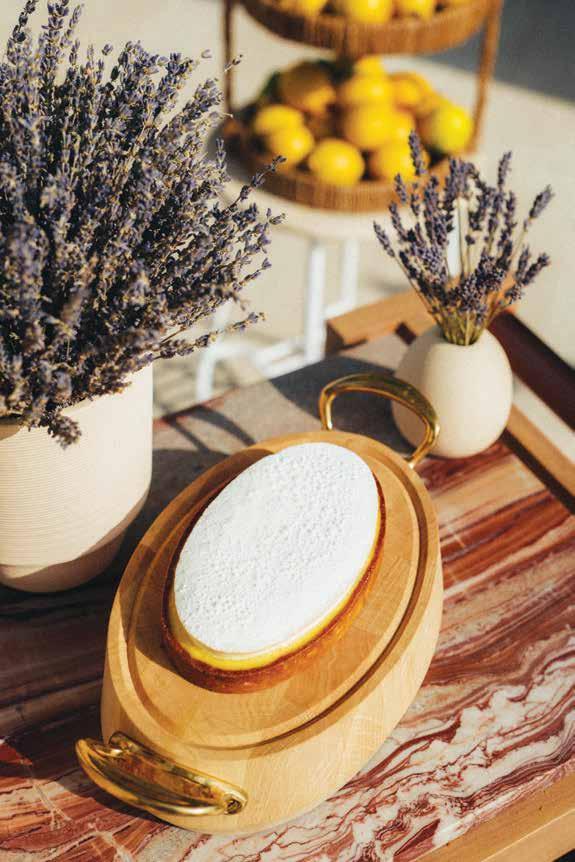




How the St.
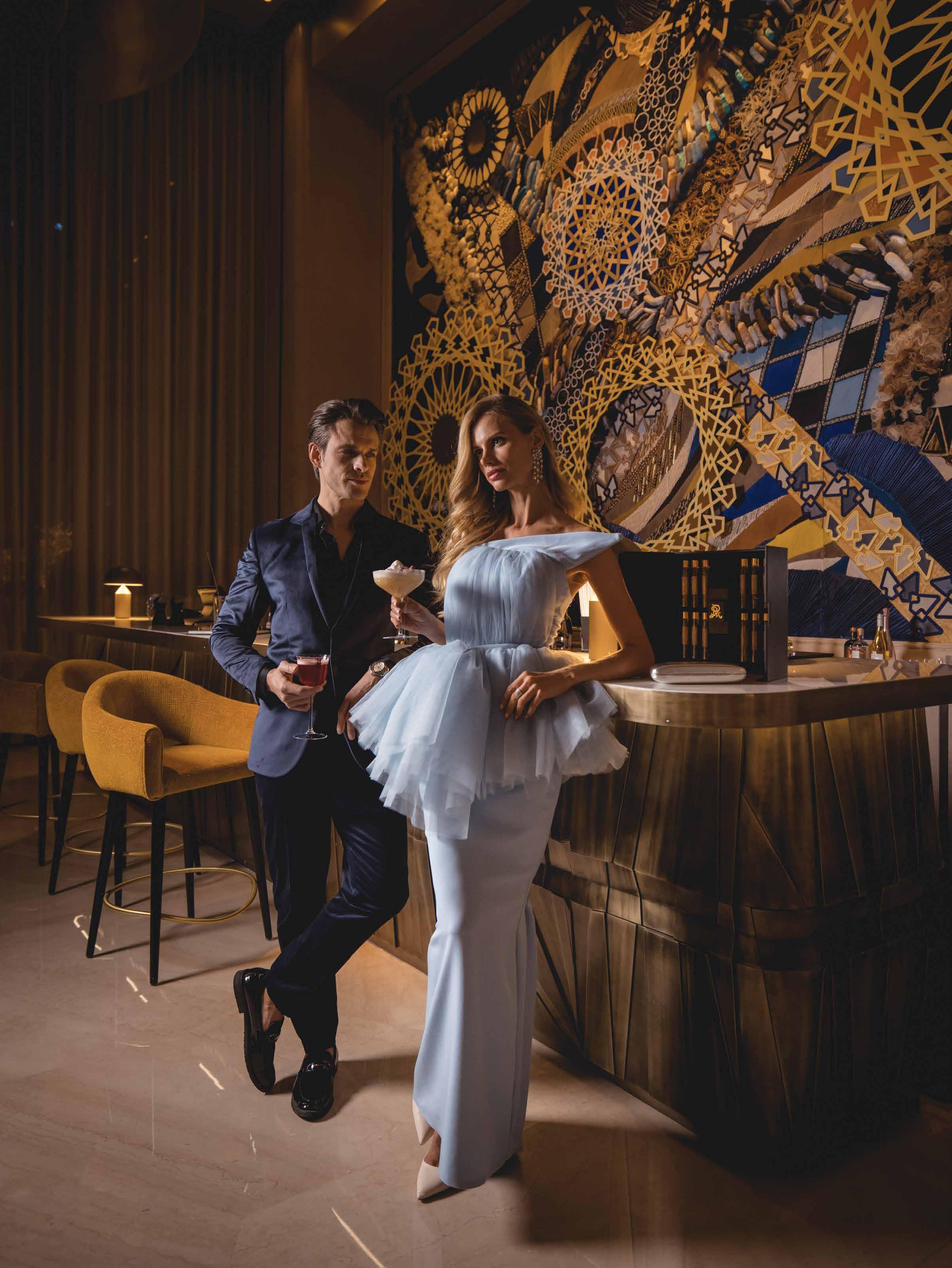
mixes the contemporary with the classic to serve up a unique experience
Few bars have a past as storied as the King Cole Bar in the St. Regis New York hotel. Since its opening in 1932, it has served everyone from Salvador Dalí to Marilyn Monroe, and yet it was a lesser-known guest, the Russian aristocrat Serge Obolensky, who is credited with ordering a drink that would become the world’s best-known cocktail. His request for a nameless vodka-based drink he had enjoyed while in Paris led bartender Fernand Petiot to devise a version spiced-up with salt, pepper, lemon and Worcestershire Sauce. It was originally christened Red Snapper, but soon adopted the name Bloody Mary.
Nearly a century on and it remains the bar’s signature cocktail.
So ingrained is the bar and its cocktail in the St. Regis story that it forms the cornerstone of every St. Regis hotel across the globe, from Mexico City to the Maldives. So how does the alcohol-free St. Regis Riyadh follow suit? By getting creative. Thinking outside of the box.
Led by Director of Food & Beverage, Pasquale Fummo, the team of mixologists at Riyadh’s St. Regis Bar are among the best in the business, elevating the once simple mocktail to an art form. Using a combination of 0% spirits that range from American malt to Italian spritz and locallysourced ingredients – the likes of dates, cardamon and cloves – the drinks served here are not only the most imaginative in Riyadh, they’re also the best.
To uphold tradition, a faithful-t0-theorginal-recipe Red Snapper is served, while the Regal Mary is an inspired take on it, with dates, sumac, cardamom and cloves adding a rich flavour. Then

there’s the new Desert Rose, a mix of Dry London 0%, cherry tomatoes, muskmelon, strawberry and sea salt.
But it’s not just the drinks that pay homage to the bar’s New York forerunner. While it has the famous mural of Old King Cole – said to contain a secret only known to those who work behind the bar – Riyadh’s version is a striking blend of the classic and contemporary; one composed of Arabesque motifs, elaborate
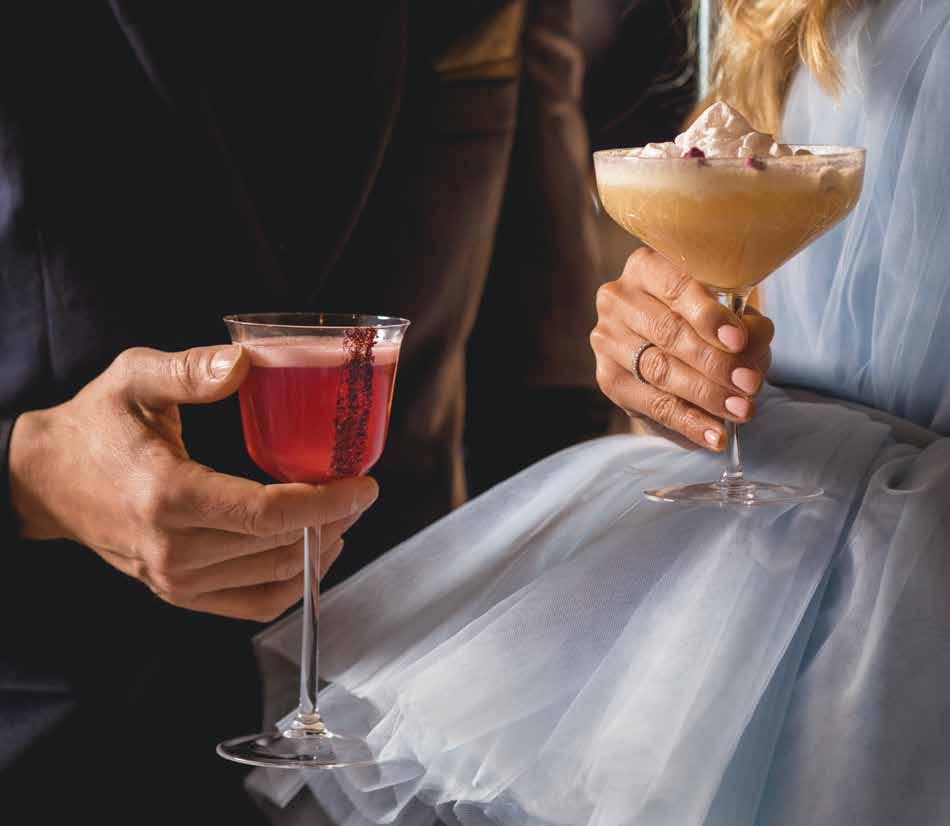
woven wools, embroidery, and beading.
“We also have our own evening ritual,” says Pasquale, referencing the St. Regis Bar’s time-honoured tradition of popping a champagne cork with a sabre at sundown each evening. Here, the fizz that’s sabered is the best 0% sparkling wine from Italy and France.
At a bar that honours the past through forward-thinking, every day is well worth celebrating.


Walter Lange, our company founder and great grandson of Ferdinand Adolph Lange, once said: “There’s something one should expect not only of a watch but also of oneself: to never stand still.” This is something I take very much to heart, because you can only develop as a person if you keep moving forward. This applies also to the way we make our watches. Over the past 30 years, since the rebirth of A. Lange & Söhne, we consistently ventured into uncharted territories of watchmaking, pushing the boundaries of what is possible.
One thing I do every, and several times, a day (and this may seem obvious) is look at my watch. Not only do I enjoy looking at the dial, but also at the back, because through the sapphire crystal you can observe the movement and all its mechanical intricacies in action. A. Lange & Söhne movements can be identified in particular by the fact that each component is decorated with its own specific type of finissage, whether or not it is visible through the sapphire-crystal caseback.
One of the most important lessons I have learnt is linked to the realisation that I am surrounded by employees who are significantly better than me in their area of expertise. When I joined A. Lange & Söhne as CEO 13 years ago, I took a lot of time to familiarise myself with the individual departments of our manufacture. I also had the chance to work on movements myself, but I quickly realised that I was better off leaving this to the experts. The positive fact that our watches are held in high esteem all over the world is primarily thanks to our highly skilled watchmakers, finishers and all the other craftspeople involved in the process.
I consider myself a petrolhead, which probably has something to do with the fact that I am the son of a car dealer. I came into contact with cars at a young age and developed a real interest for the mechanics. My most important car is an MGB Roadster and it is special to me as it was the first classic car I ever bought, 40 years ago. The sense of mobility, me driving in a classic car through a beautiful landscape, keeps me grounded, lets me
unwind. Furthermore, there is a great deal of common ground between vintage cars and our approach to watchmaking: ultimate craftsmanship, technical innovation and unrivalled heritage.
In my role it is difficult to recognise certain achievements as a personal success. After all, success is primarily due to the fact that you have worked well together as a team. In this respect, I am happy to work with highly qualified people who share something very essential: a passion for the way we make our watches.
I would tell my younger self to stick to your passions. I really enjoy the fact that I can indulge in one of my two passions –cars and watches – professionally. It is a great privilege to have been able to work in the areas that have always inspired me.
A. Lange & Söhne can only remain successful if we continue to focus on the highest quality and fulfil our customers’ expectations. We have learned that the best way to tell our story is to tell it ourselves.

